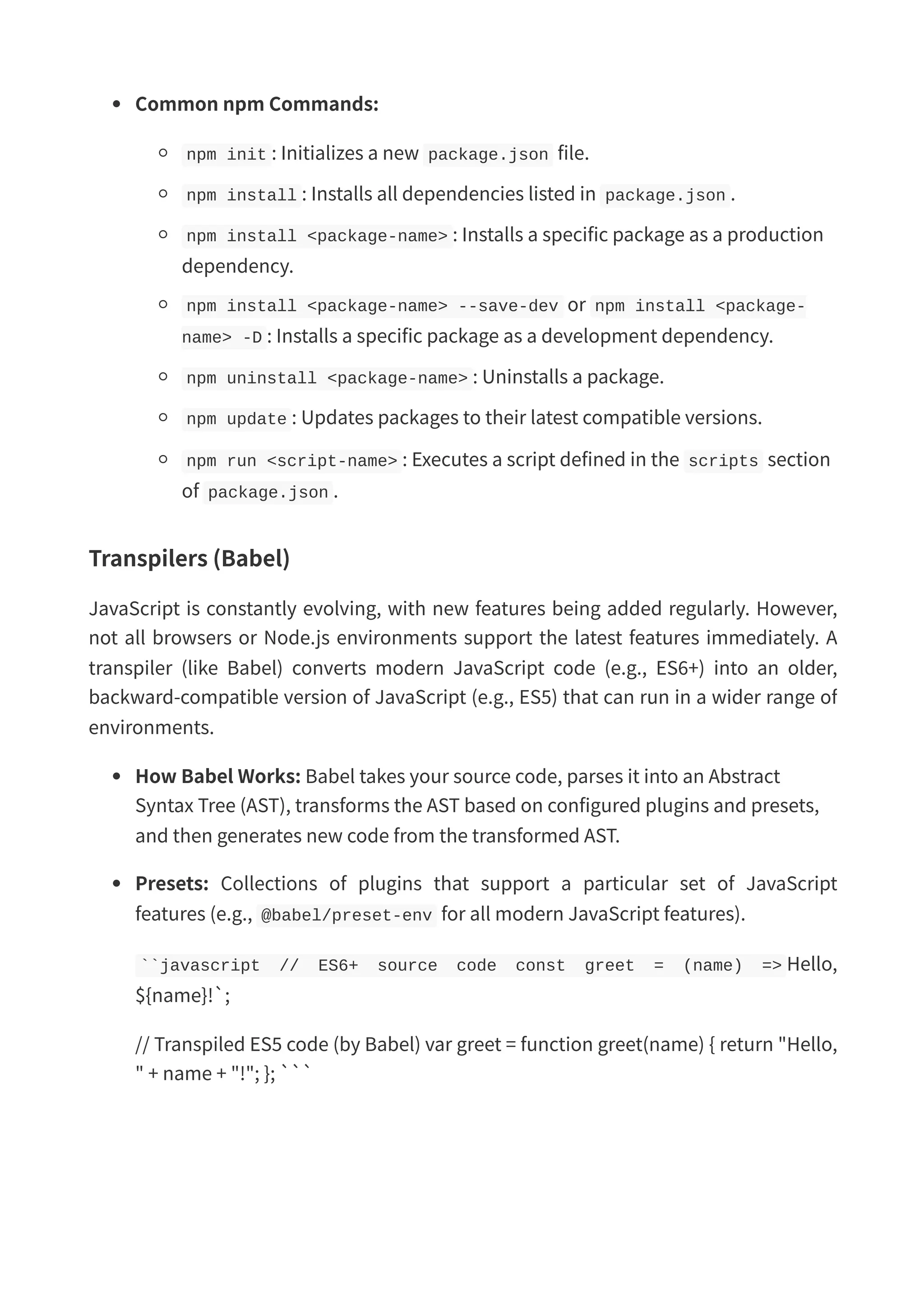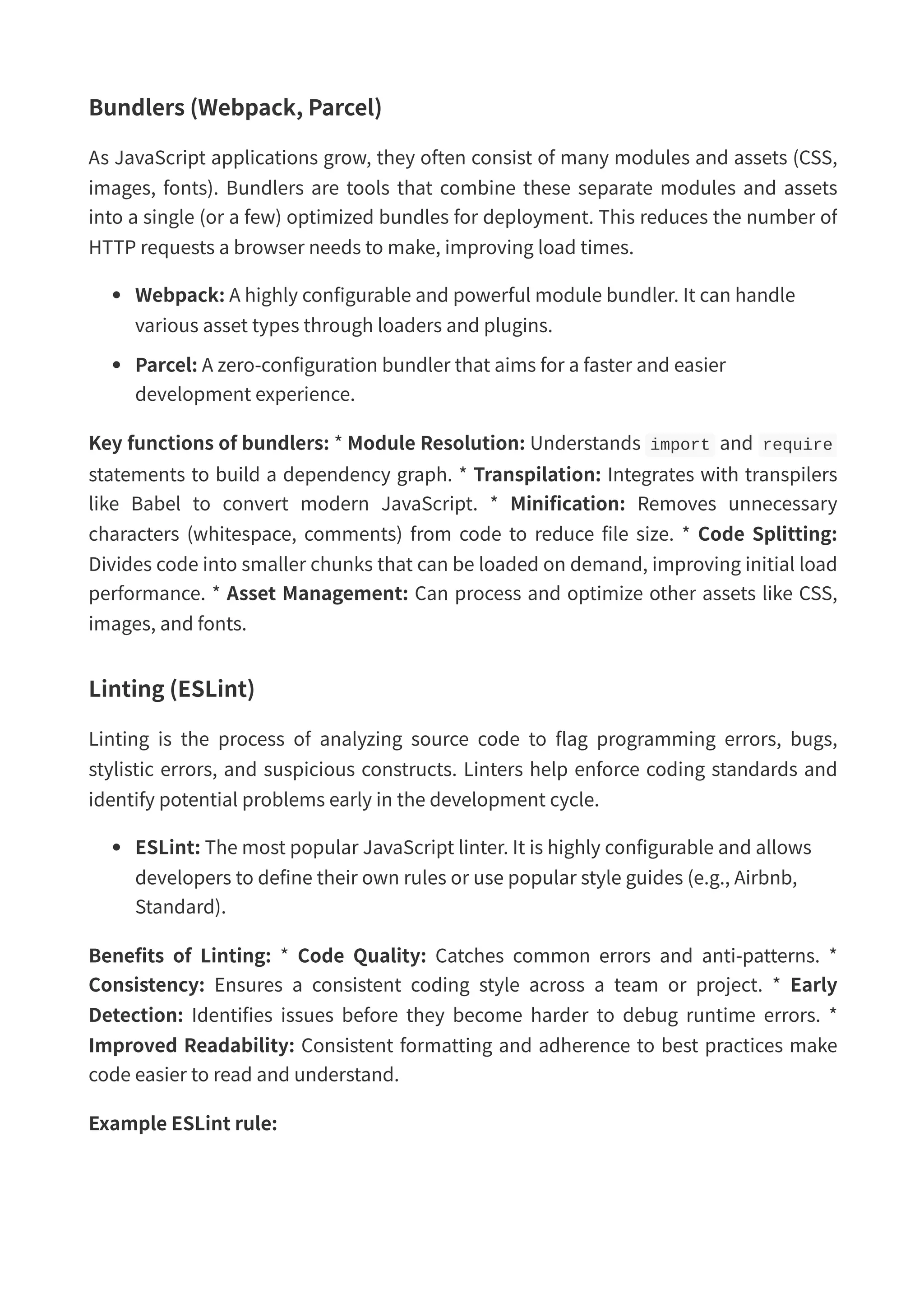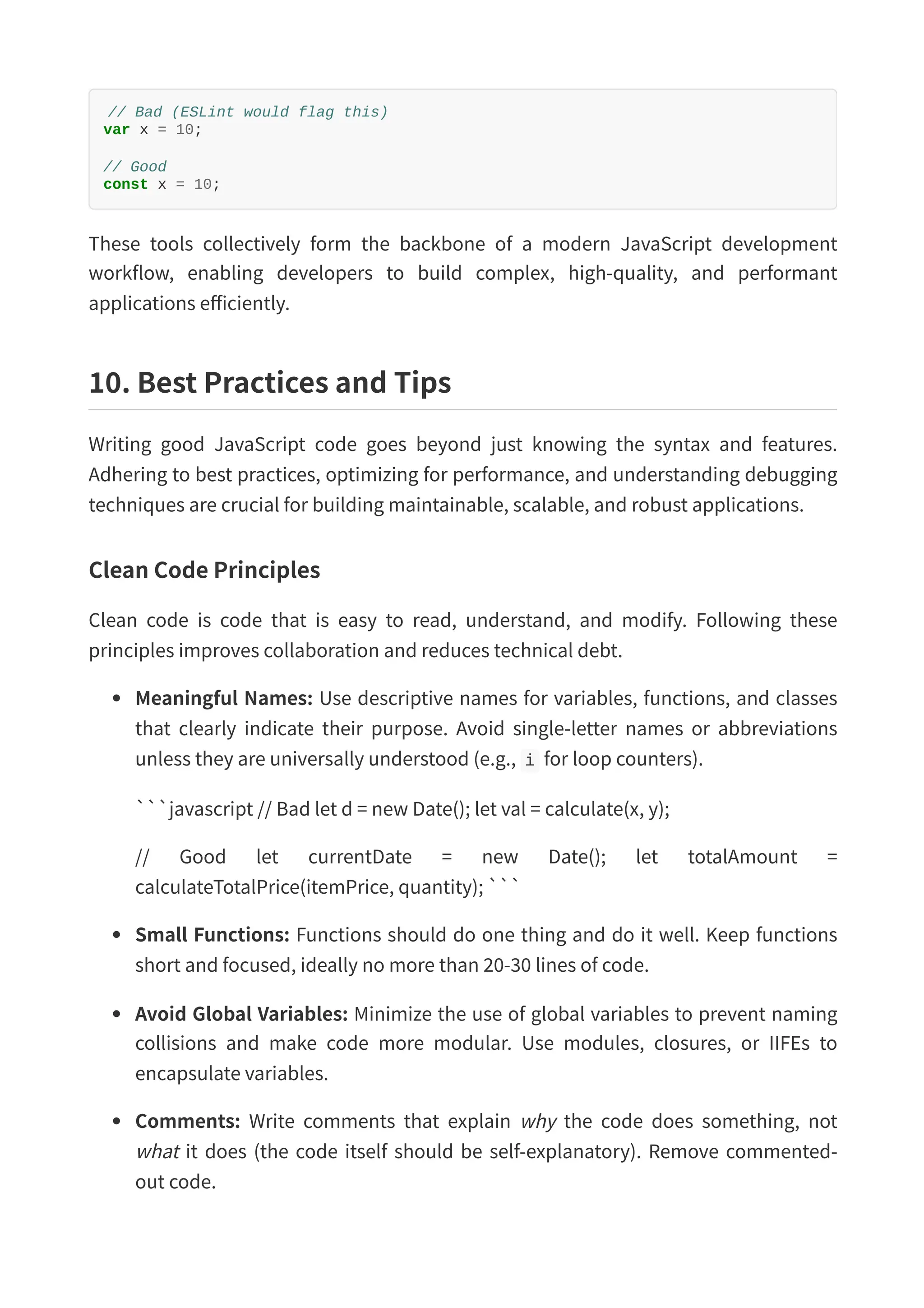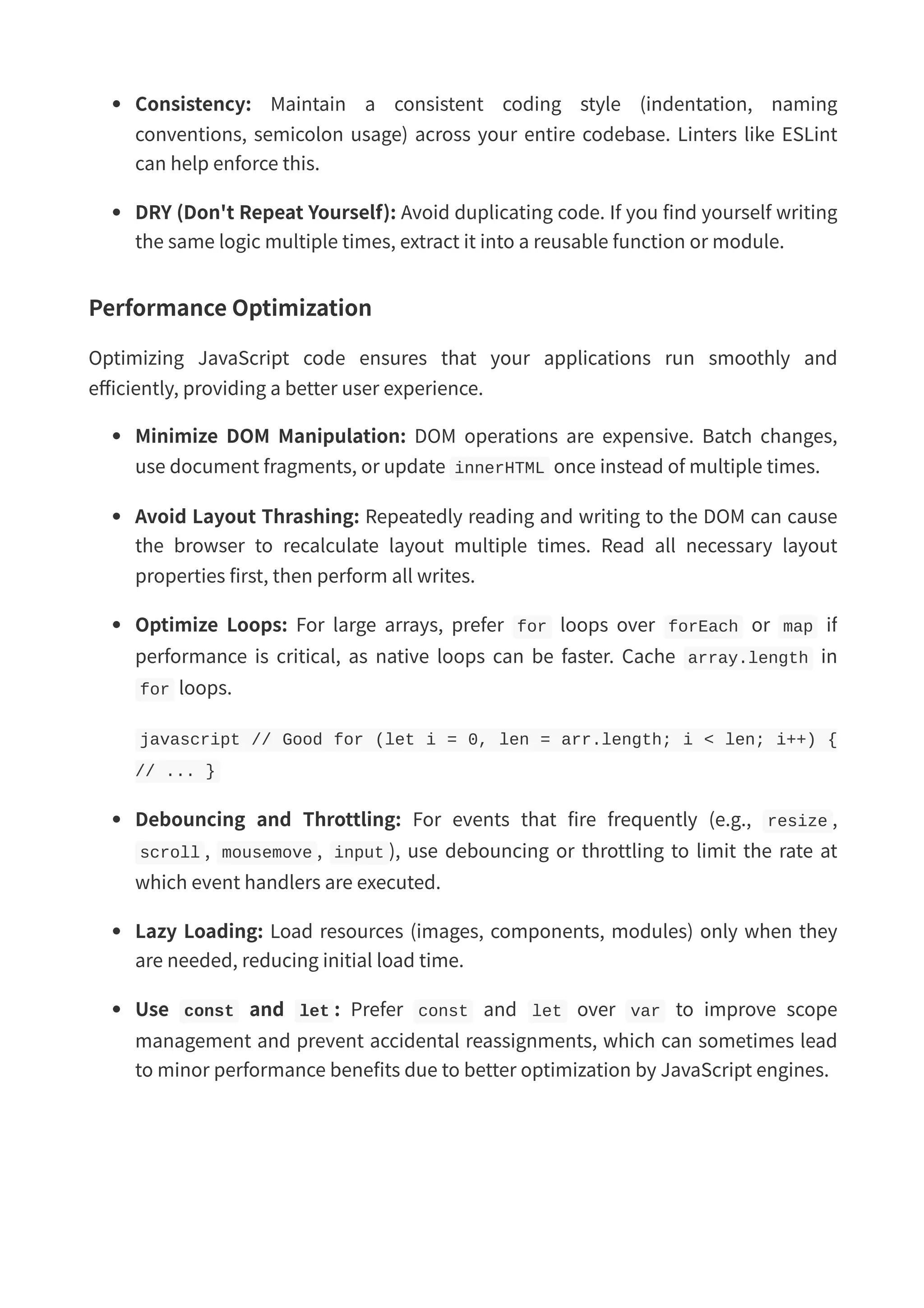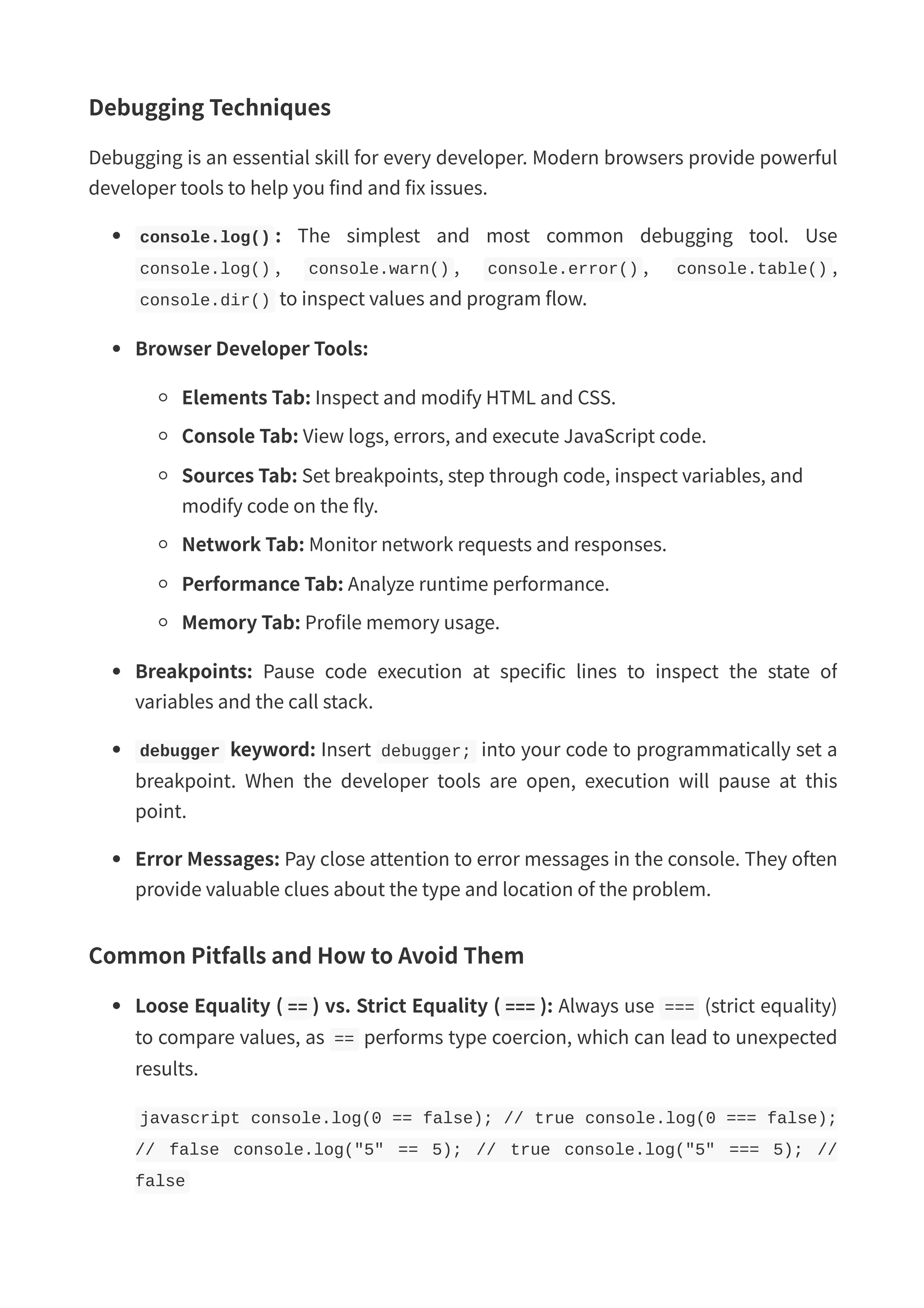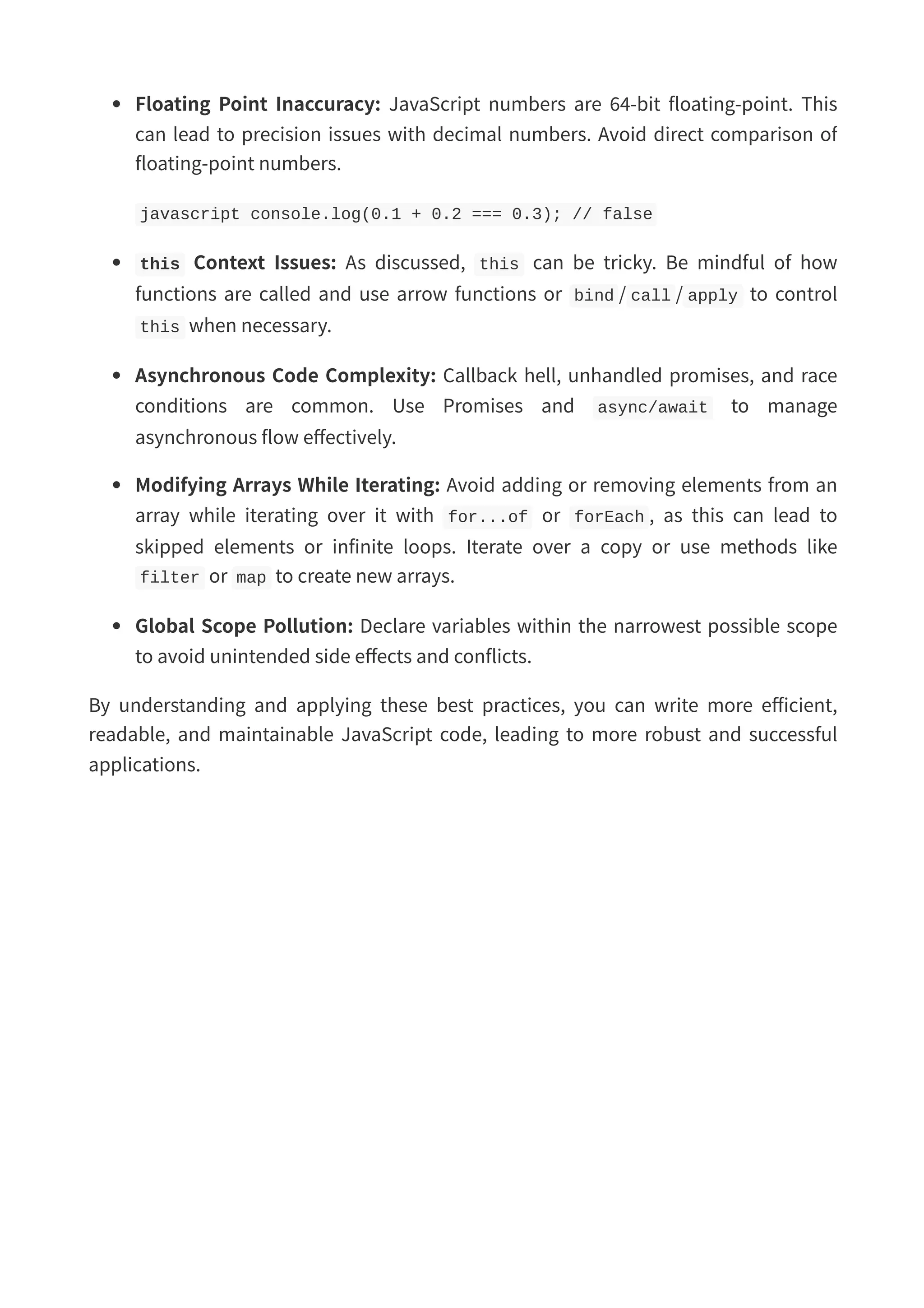Comprehensive JavaScript notes covering fundamental concepts, data types, functions, objects, arrays, asynchronous programming, DOM manipulation, ES6+ features, and advanced topics like 'this' and prototypes. Ideal for beginners and experienced developers.
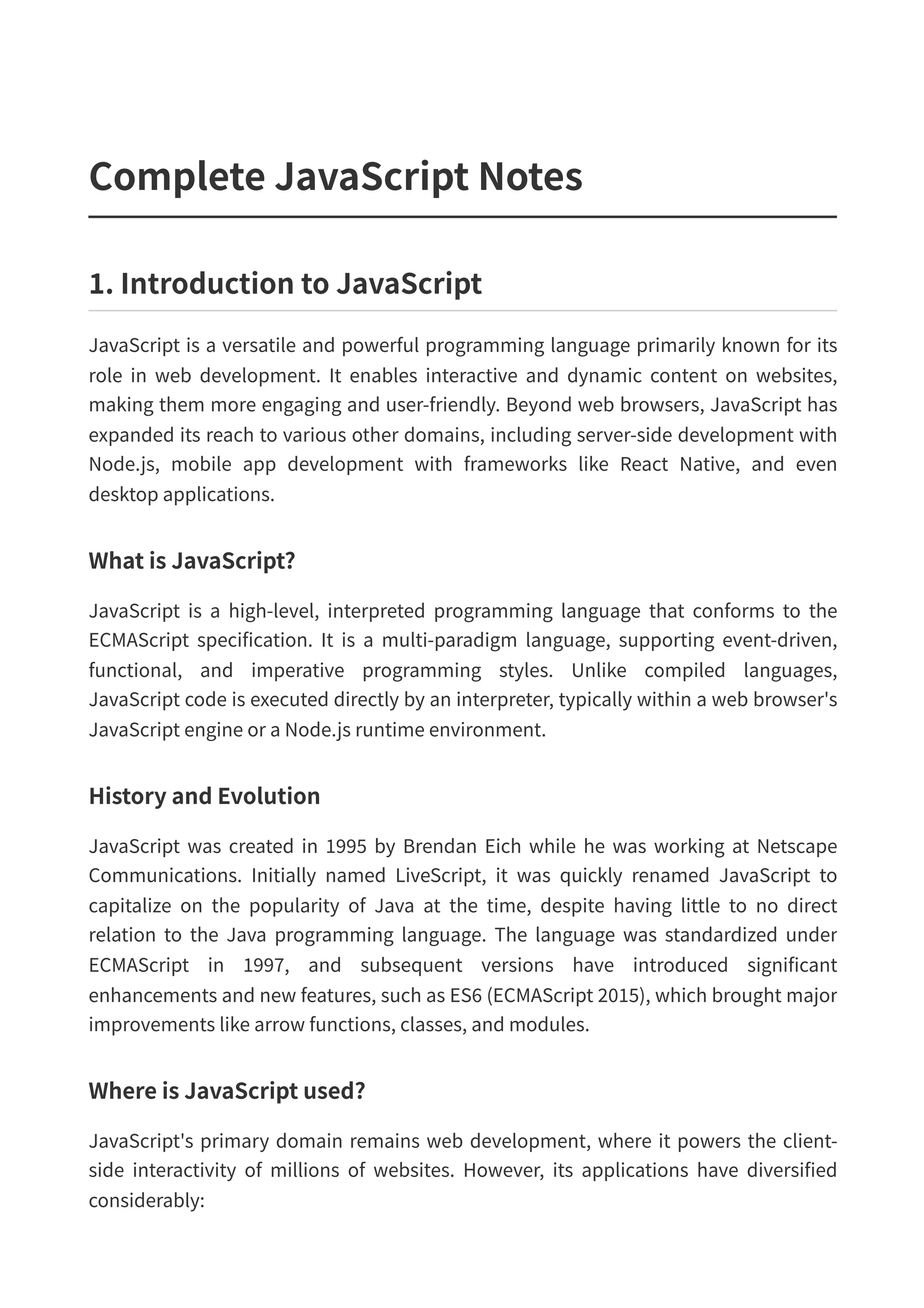
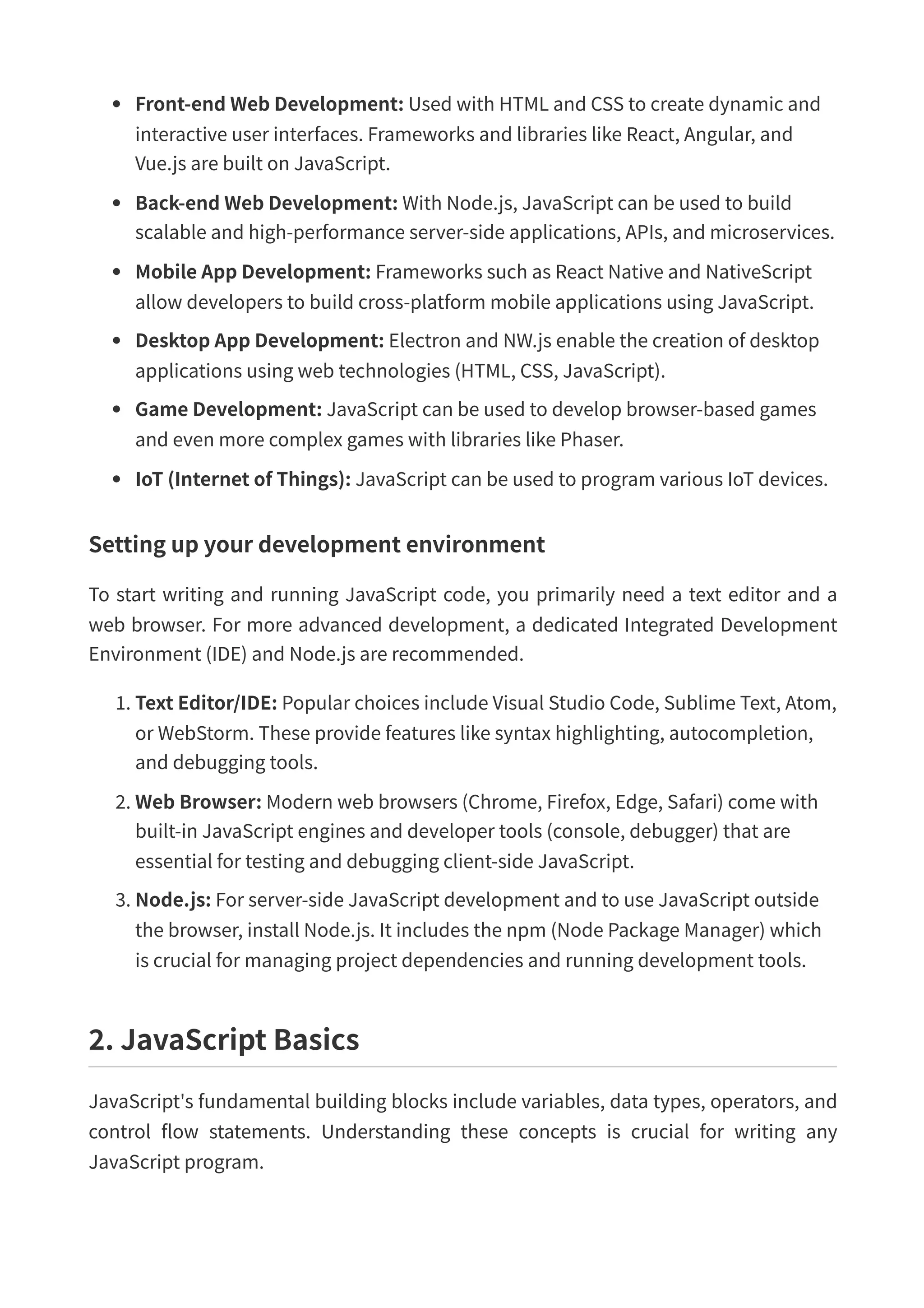
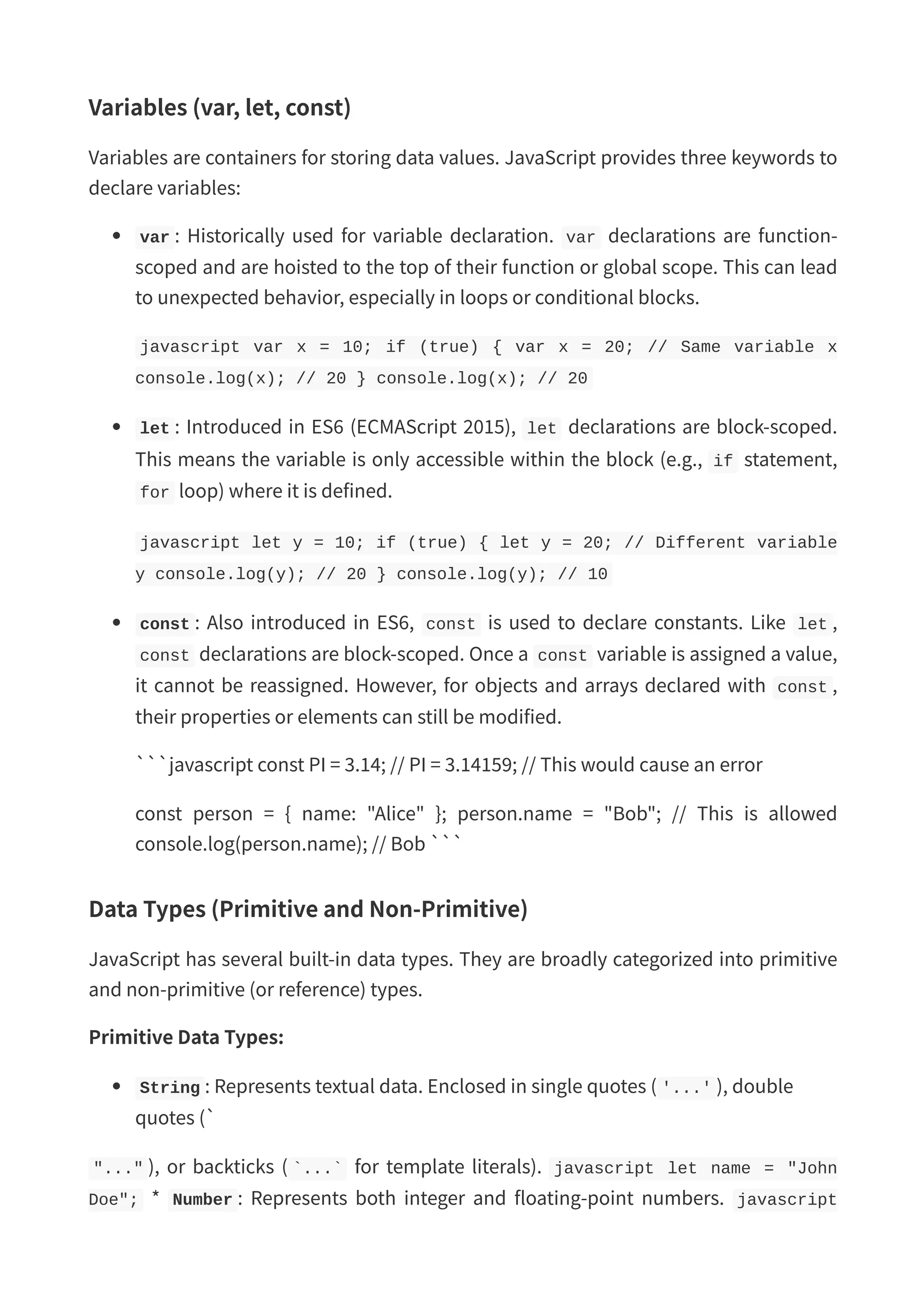
![let age = 30; let price = 99.99; * Boolean : Represents a logical entity and can have two values: true or false . javascript let isActive = true; * Undefined : Represents a variable that has been declared but has not yet been assigned a value. javascript let city; // city is undefined * Null : Represents the intentional absence of any object value. It is a primitive value. javascript let car = null; * Symbol : (ES6) Represents a unique identifier. Used to create unique property keys that won't clash with other property keys. javascript const id = Symbol('id'); * BigInt : (ES2020) Represents whole numbers larger than 2^53 - 1, which is the largest number JavaScript can reliably represent with the Number primitive. javascript const bigNumber = 1234567890123456789012345678901234567890n; Non-Primitive (Reference) Data Types: Object : A collection of key-value pairs. Objects are the most fundamental non- primitive data type. javascript let person = { firstName: "John", lastName: "Doe" }; Array : A special type of object used to store ordered collections of data. javascript let colors = ["red", "green", "blue"]; Function : A block of code designed to perform a particular task. Functions are also objects in JavaScript. javascript function greet(name) { return "Hello, " + name; } Operators (Arithmetic, Assignment, Comparison, Logical, etc.) Operators are symbols that perform operations on operands (values and variables). Arithmetic Operators: Perform mathematical calculations.](https://image.slidesharecdn.com/javascriptnotes-250711141925-adda0041/75/Complete-JavaScript-Notes-From-Basics-to-Advanced-Concepts-pdf-4-2048.jpg)
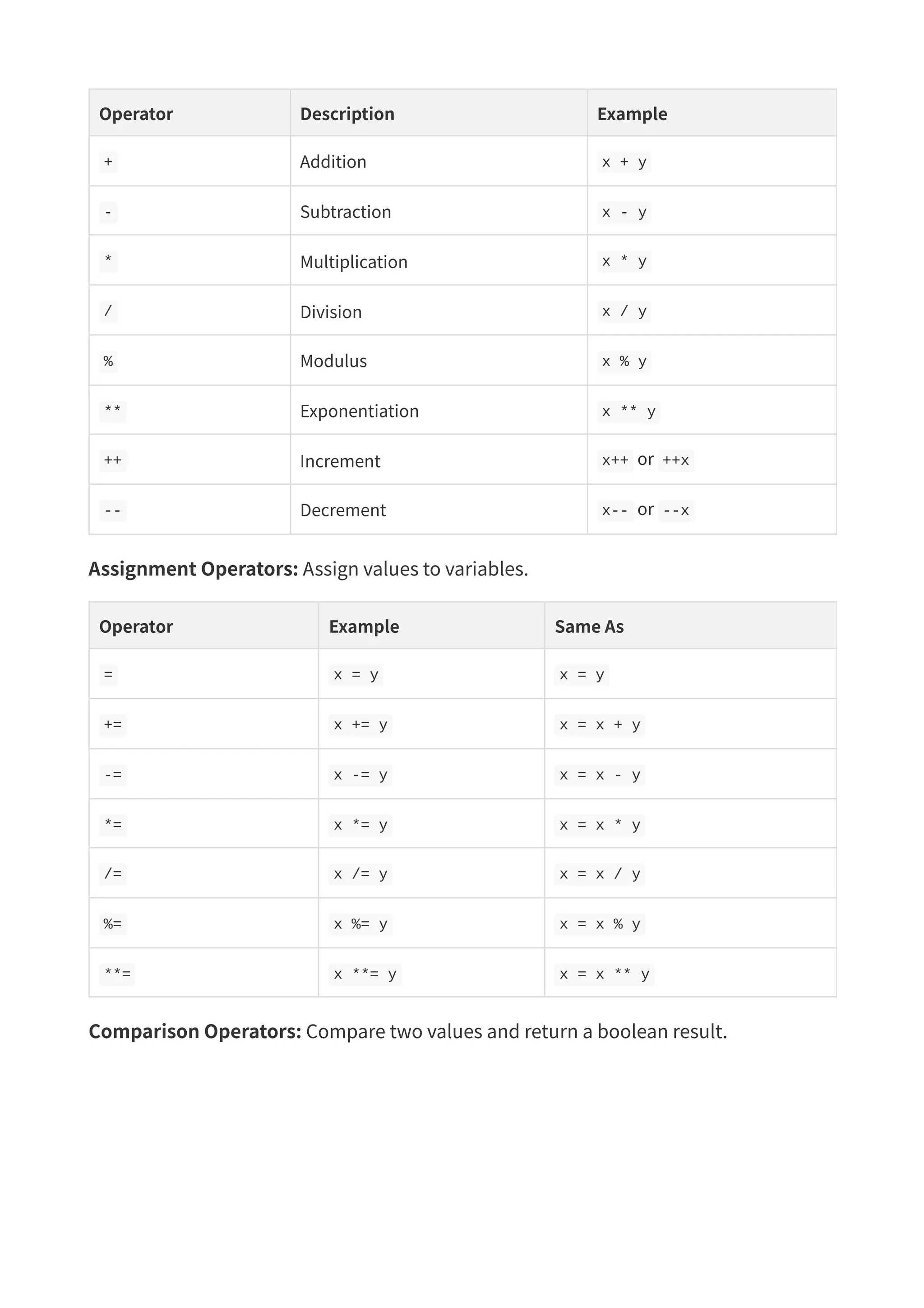
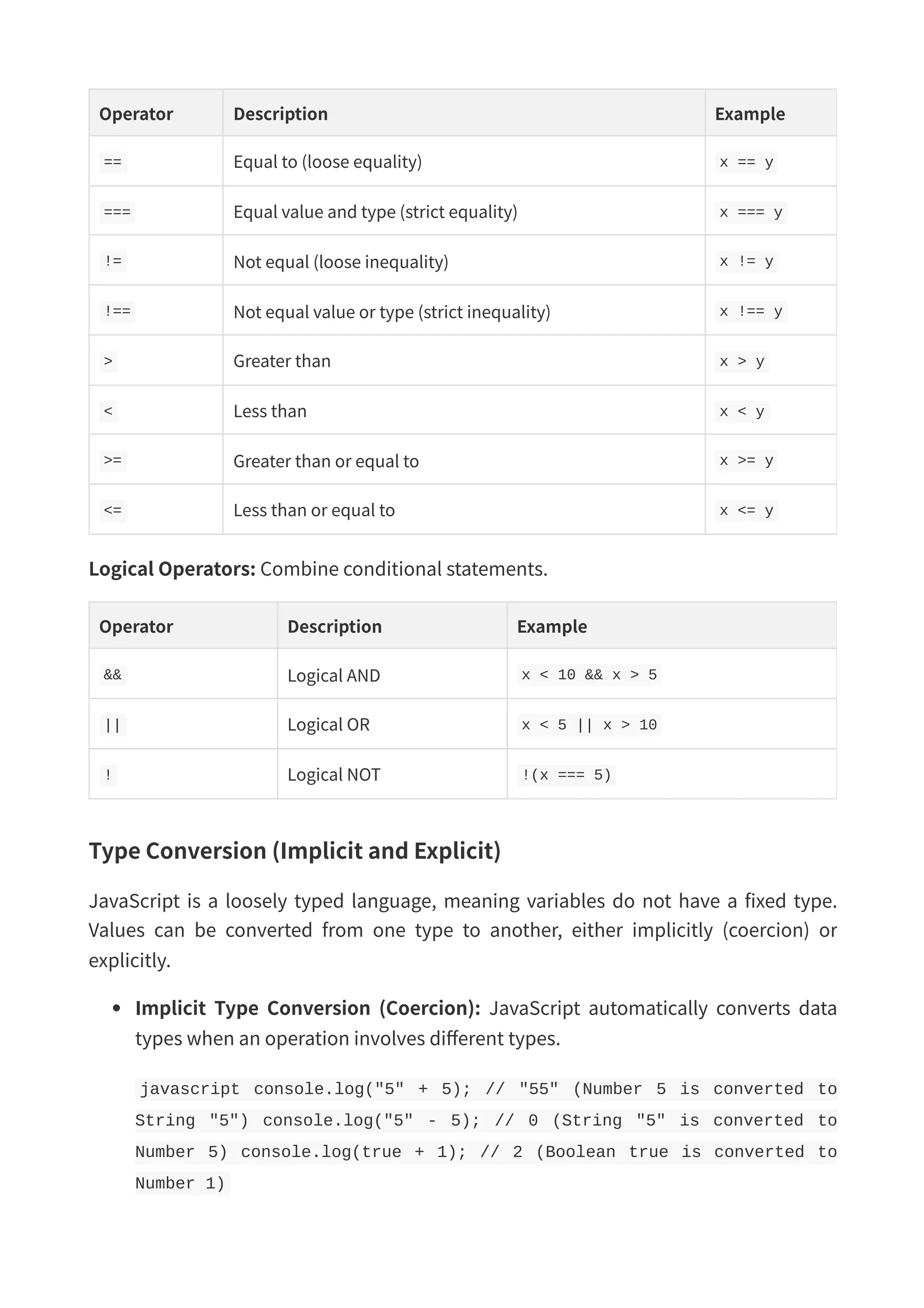
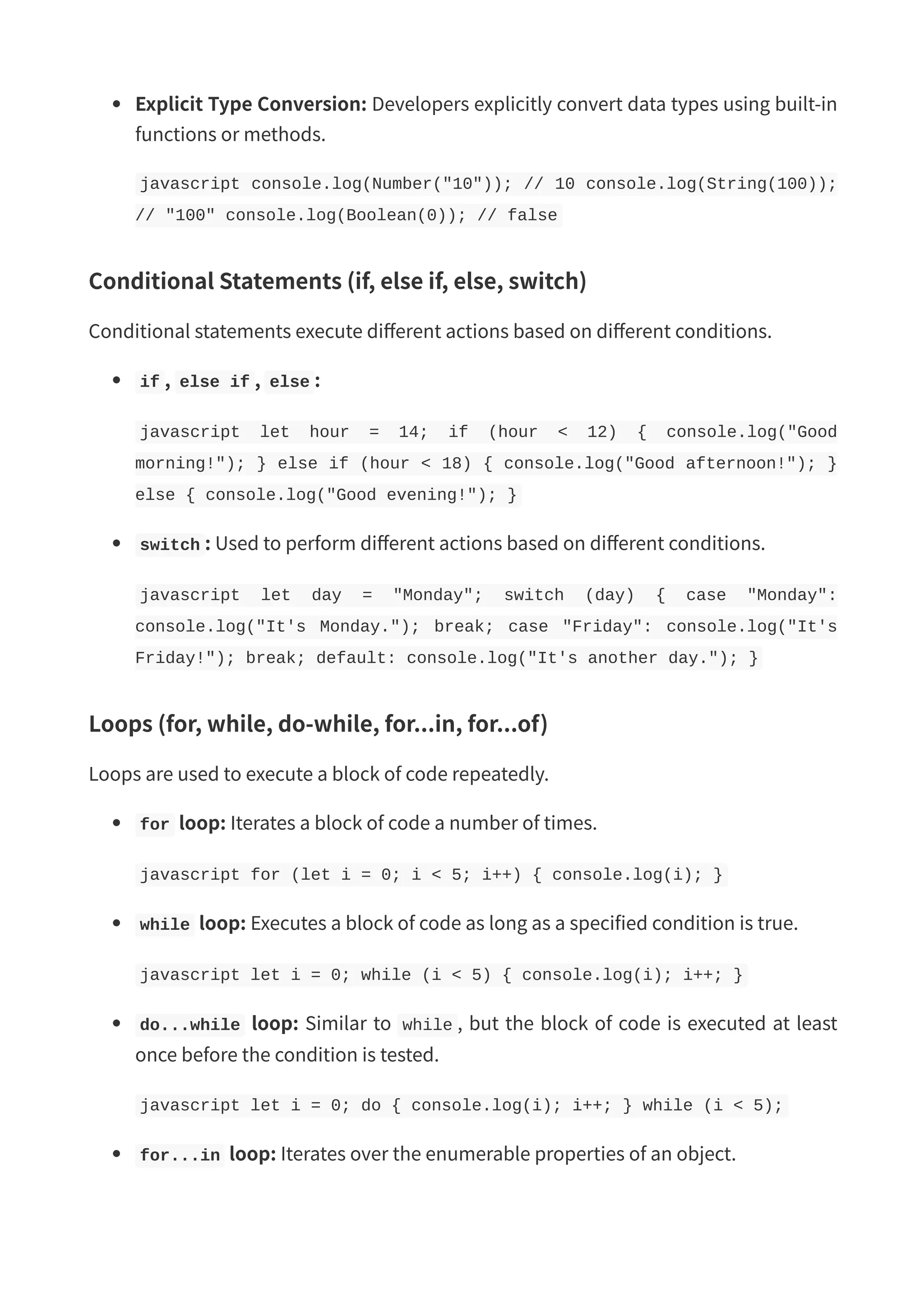
![javascript const person = { fname: "John", lname: "Doe", age: 25 }; for (let x in person) { console.log(x + ": " + person[x]); } for...of loop: (ES6) Iterates over iterable objects (like Arrays, Strings, Maps, Sets, etc.). javascript const colors = ["red", "green", "blue"]; for (let color of colors) { console.log(color); } 3. Functions Functions are fundamental building blocks in JavaScript. They are reusable blocks of code that perform a specific task. Functions allow you to organize your code, make it more modular, and avoid repetition (DRY - Don't Repeat Yourself principle). Function Declaration and Expression There are two primary ways to define functions in JavaScript: Function Declaration (or Function Statement): This is the most common way to define a function. Function declarations are hoisted, meaning they can be called before they are defined in the code. ```javascript // Function Declaration function greet(name) { return "Hello, " + name + "!"; } console.log(greet("Alice")); // Output: Hello, Alice! ``` Function Expression: A function expression defines a function as part of an expression, typically assigned to a variable. Function expressions are not hoisted, so they cannot be called before they are defined. ```javascript // Function Expression const sayHello = function(name) { return "Hello, " + name + "!"; }; console.log(sayHello("Bob")); // Output: Hello, Bob! // console.log(anotherGreet("Charlie")); // This would cause an error if called before definition ```](https://image.slidesharecdn.com/javascriptnotes-250711141925-adda0041/75/Complete-JavaScript-Notes-From-Basics-to-Advanced-Concepts-pdf-8-2048.jpg)
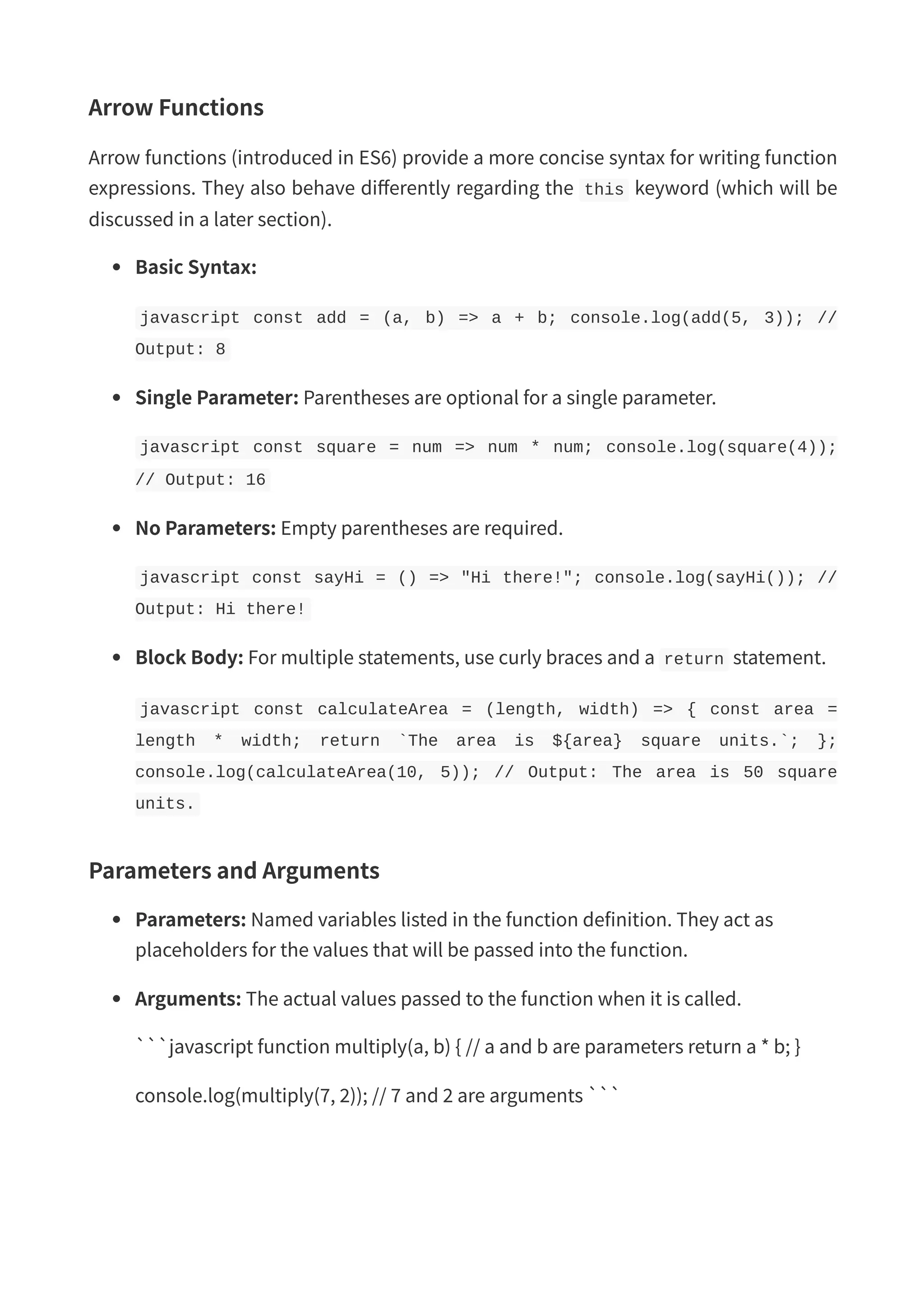
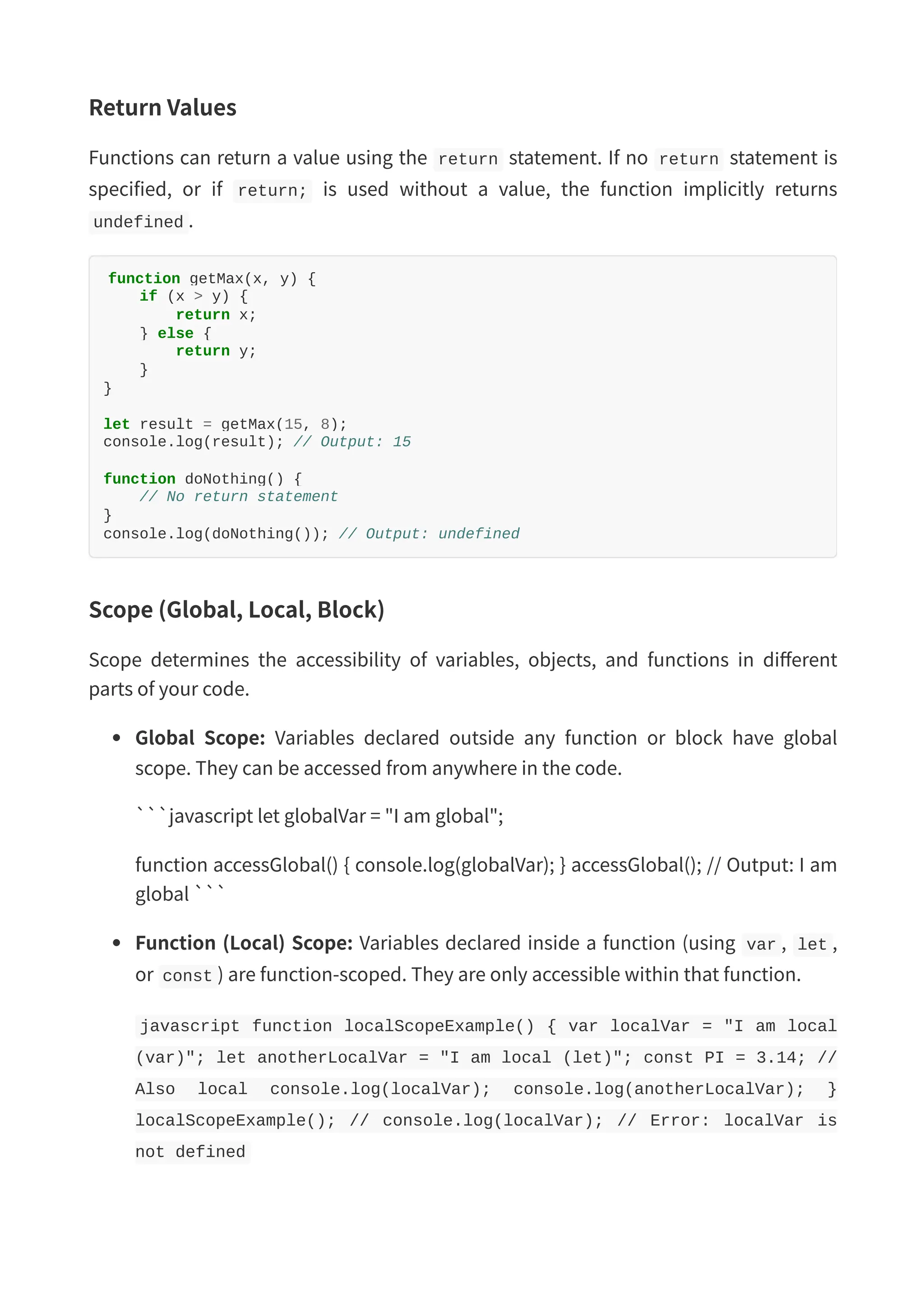
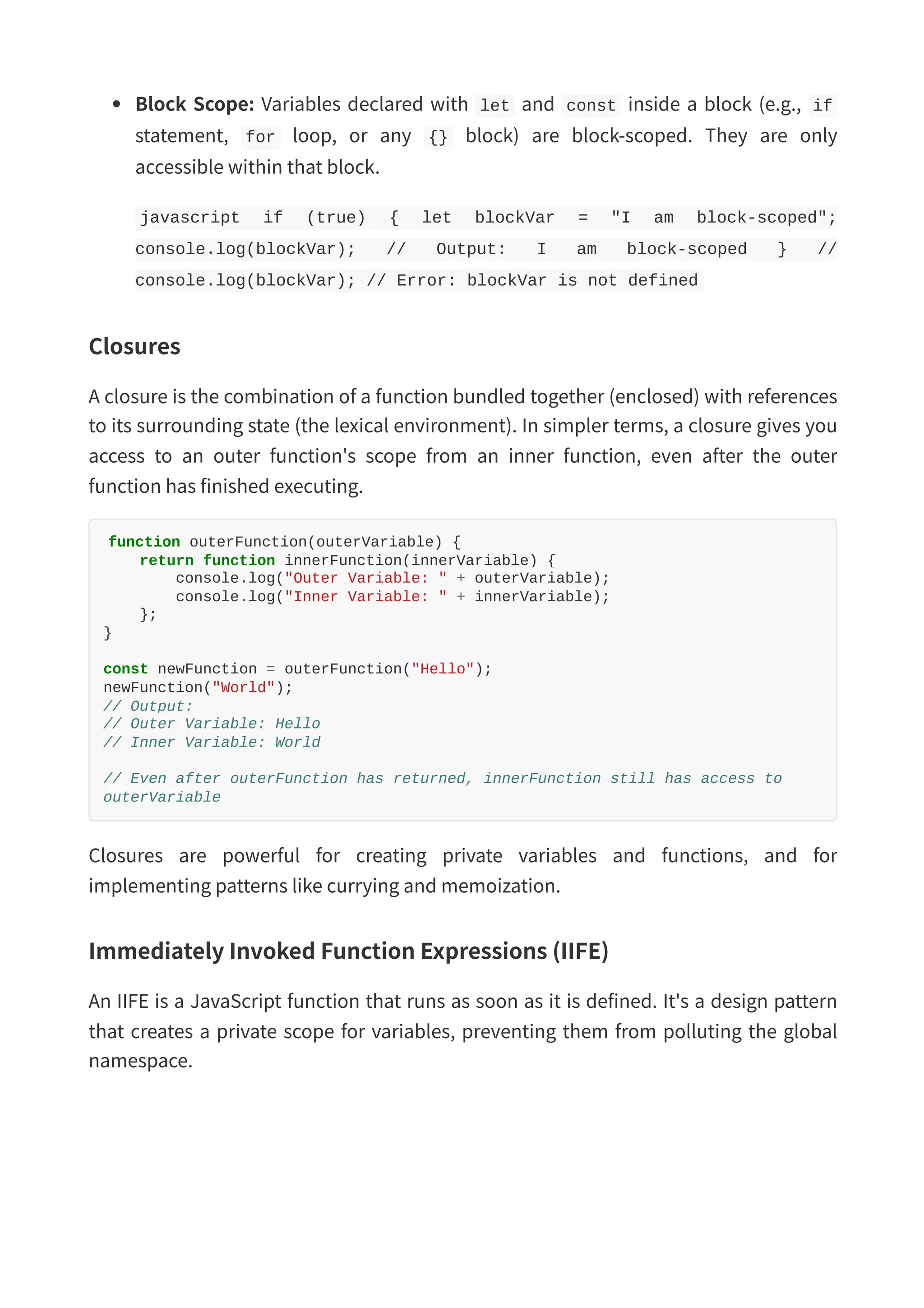
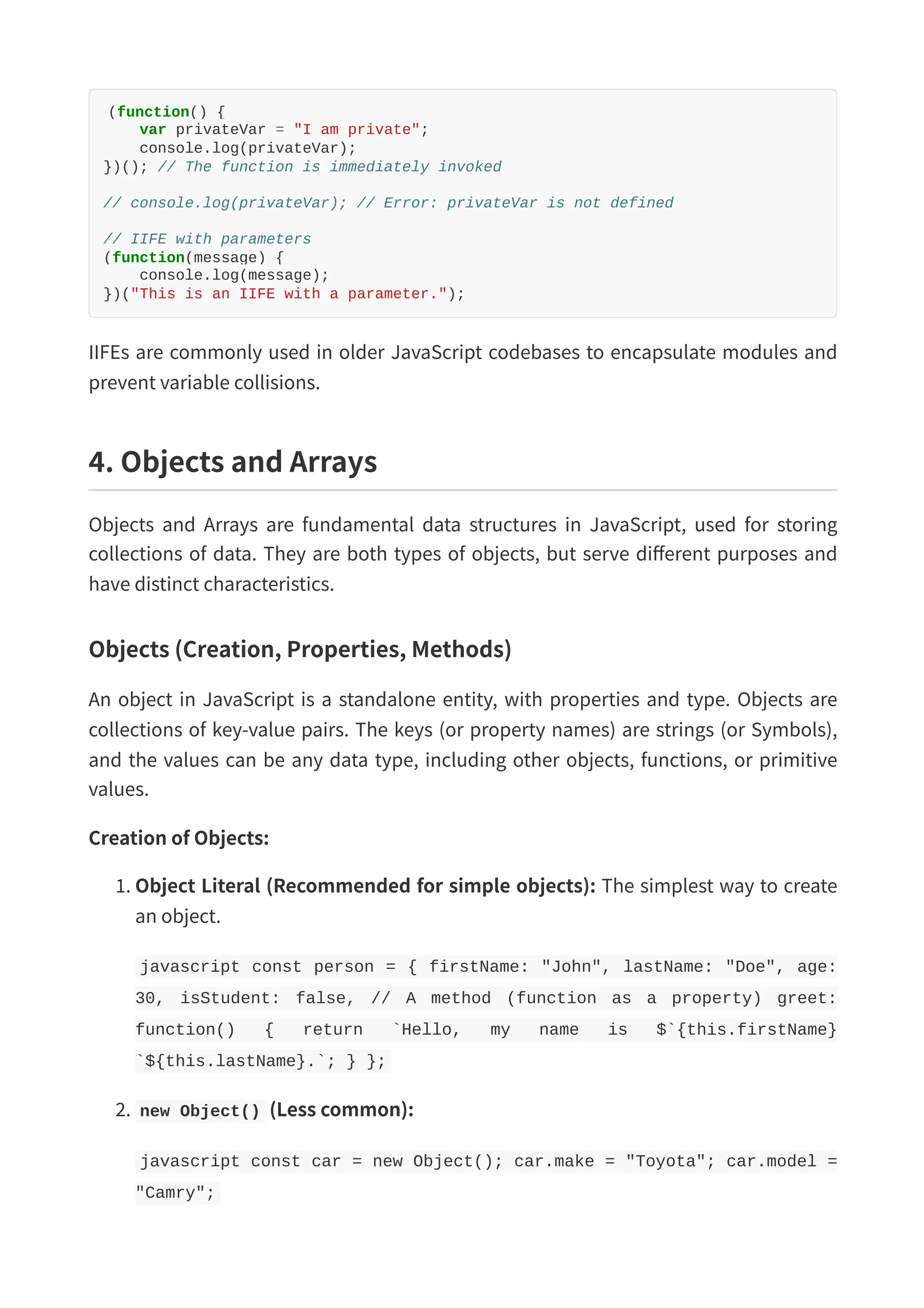
![3. Constructor Function: Used to create multiple objects of the same type. ``javascript function Book(title, author, year) { this.title = title; this.author = author; this.year = year; this.getSummary = function() { return $ {this.title} by ${this.author}, published in ${this.year}.`; }; } const book1 = new Book("The Hobbit", "J.R.R. Tolkien", 1937); console.log(book1.getSummary()); ``` 4. class Keyword (ES6): Syntactic sugar over constructor functions and prototypes. ```javascript class Animal { constructor(name, species) { this.name = name; this.species = species; } makeSound() { console.log("Generic animal sound"); } } const dog = new Animal("Buddy", "Dog"); dog.makeSound(); ``` Accessing Properties: Dot Notation (Recommended): javascript console.log(person.firstName); // "John" Bracket Notation (Useful for dynamic property names or properties with special characters): javascript console.log(person["lastName"]); // "Doe" let prop = "age"; console.log(person[prop]); // 30 Modifying Properties: person.age = 31; person["isStudent"] = true; console.log(person.age); // 31 console.log(person.isStudent); // true Adding New Properties:](https://image.slidesharecdn.com/javascriptnotes-250711141925-adda0041/75/Complete-JavaScript-Notes-From-Basics-to-Advanced-Concepts-pdf-13-2048.jpg)
![person.nationality = "American"; console.log(person.nationality); // "American" Deleting Properties: delete person.isStudent; console.log(person.isStudent); // undefined Methods: Functions stored as object properties. console.log(person.greet()); // "Hello, my name is John Doe." Arrays (Creation, Methods, Iteration) Arrays are ordered collections of values. Each value is called an element, and each element has a numeric position called an index (starting from 0). Creation of Arrays: 1. Array Literal (Recommended): javascript const fruits = ["apple", "banana", "cherry"]; const numbers = [1, 2, 3, 4, 5]; const mixed = ["text", 123, true, { key: "value" }]; 2. new Array() (Less common): javascript const emptyArray = new Array(); const fiveElements = new Array(5); // Creates an array with 5 empty slots const colors = new Array("red", "green", "blue"); Accessing Elements: Elements are accessed using their index in bracket notation. console.log(fruits[0]); // "apple" console.log(fruits[2]); // "cherry" console.log(fruits.length); // 3 Modifying Elements:](https://image.slidesharecdn.com/javascriptnotes-250711141925-adda0041/75/Complete-JavaScript-Notes-From-Basics-to-Advanced-Concepts-pdf-14-2048.jpg)
![fruits[1] = "grape"; console.log(fruits); // ["apple", "grape", "cherry"] Common Array Methods: JavaScript provides a rich set of built-in methods for manipulating arrays.](https://image.slidesharecdn.com/javascriptnotes-250711141925-adda0041/75/Complete-JavaScript-Notes-From-Basics-to-Advanced-Concepts-pdf-15-2048.jpg)
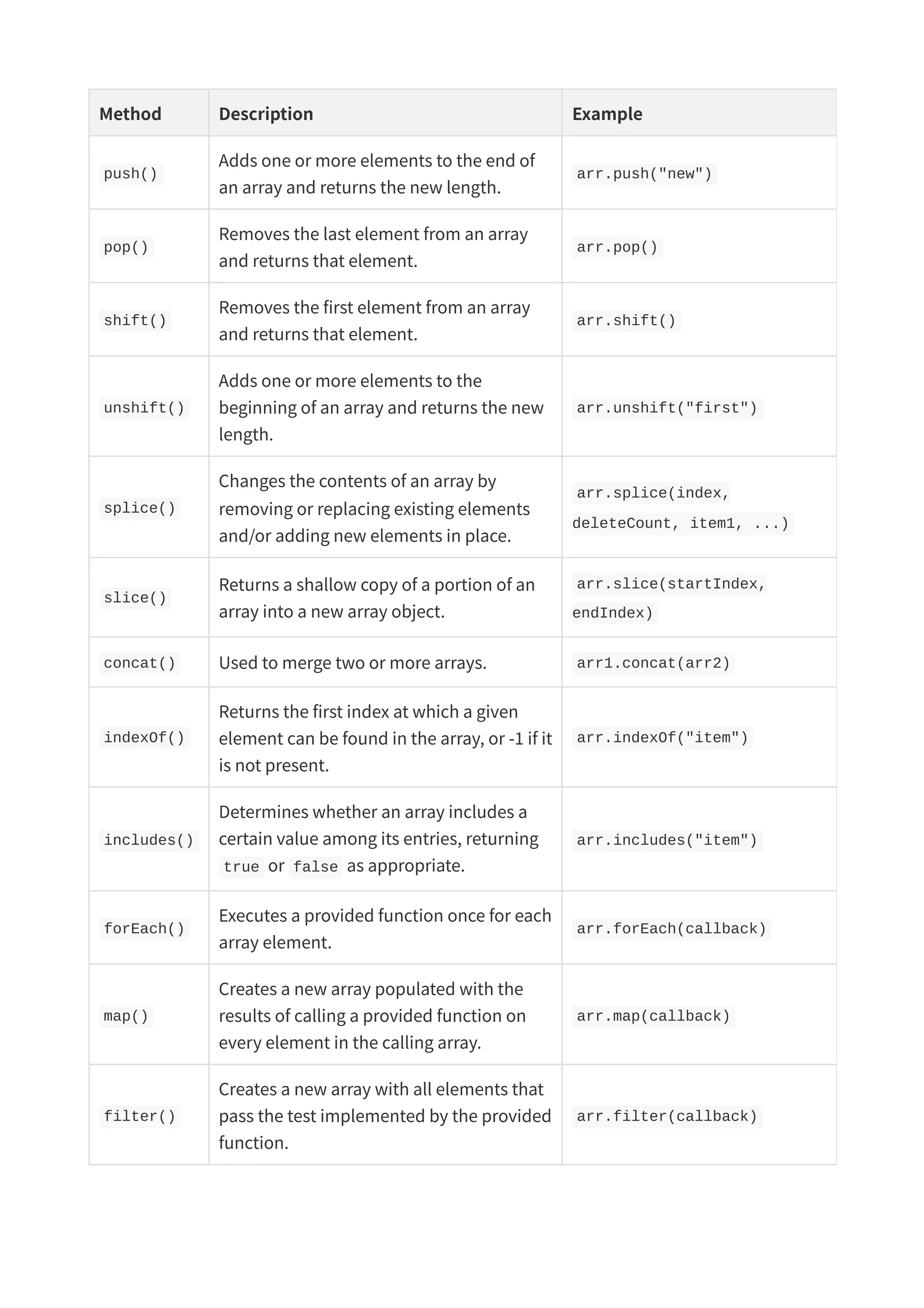
![Method Description Example reduce() Executes a reducer function (that you provide) on each element of the array, resulting in single output value. arr.reduce(callback, initialValue) find() Returns the value of the first element in the provided array that satisfies the provided testing function. arr.find(callback) sort() Sorts the elements of an array in place and returns the sorted array. arr.sort() reverse() Reverses an array in place. arr.reverse() Iteration over Arrays: for loop: javascript for (let i = 0; i < fruits.length; i++) { console.log(fruits[i]); } forEach() method: javascript fruits.forEach(function(fruit, index) { console.log(`$`{index}: `${fruit}`); }); for...of loop (ES6): javascript for (const fruit of fruits) { console.log(fruit); } Destructuring (Object and Array) Destructuring assignment is a special syntax that allows you to unpack values from arrays, or properties from objects, into distinct variables. Object Destructuring: ```javascript const person = { name: "Alice", age: 25, city: "New York" }; const { name, age } = person; console.log(name); // "Alice" console.log(age); // 25](https://image.slidesharecdn.com/javascriptnotes-250711141925-adda0041/75/Complete-JavaScript-Notes-From-Basics-to-Advanced-Concepts-pdf-17-2048.jpg)
![// Renaming variables const { name: personName, city: personCity } = person; console.log(personName); // "Alice" console.log(personCity); // "New York" ``` Array Destructuring: ```javascript const colors = ["red", "green", "blue"]; const [firstColor, secondColor] = colors; console.log(firstColor); // "red" console.log(secondColor); // "green" // Skipping elements const [,, thirdColor] = colors; console.log(thirdColor); // "blue" // With rest operator const [primary, ...restColors] = colors; console.log(primary); // "red" console.log(restColors); // ["green", "blue"] ``` Spread and Rest Operators Both the spread ( ... ) and rest ( ... ) operators use the same syntax but serve different purposes based on where they are used. Spread Operator ( ... ): Expands an iterable (like an array or string) into individual elements. Useful for copying arrays, merging arrays, or passing multiple arguments to a function. ```javascript // Copying an array const originalArray = [1, 2, 3]; const copiedArray = [...originalArray]; // [1, 2, 3] // Merging arrays const arr1 = [1, 2]; const arr2 = [3, 4]; const mergedArray = [...arr1, ...arr2]; // [1, 2, 3, 4] // Spreading properties in objects (ES2018) const obj1 = { a: 1, b: 2 }; const obj2 = { c: 3, d: 4 }; const mergedObject = { ...obj1, ...obj2 }; // { a: 1, b: 2, c: 3, d: 4 } // Passing arguments to a function function sum(a, b, c) { return a + b + c; } const nums = [1, 2, 3]; console.log(sum(...nums)); // 6 ``` Rest Operator ( ... ): Collects multiple elements into an array. Used in function parameters to handle an indefinite number of arguments, or in destructuring assignments. ```javascript // In function parameters function collectArgs(firstArg, ...restArgs) { console.log(firstArg); // "A" console.log(restArgs); // ["B", "C", "D"] }](https://image.slidesharecdn.com/javascriptnotes-250711141925-adda0041/75/Complete-JavaScript-Notes-From-Basics-to-Advanced-Concepts-pdf-18-2048.jpg)
![collectArgs("A", "B", "C", "D"); // In array destructuring (as shown above) const [head, ...tail] = [1, 2, 3, 4]; console.log(head); // 1 console.log(tail); // [2, 3, 4] ``` 5. Asynchronous JavaScript JavaScript is a single-threaded language, meaning it can only execute one task at a time. However, many operations, such as fetching data from a server, reading a file, or waiting for a user action, can take time. If these operations were synchronous (blocking), the entire application would freeze until they completed. Asynchronous programming allows JavaScript to handle these long-running tasks without blocking the main thread, ensuring a smooth and responsive user experience. Callbacks A callback is a function passed as an argument to another function, which is then invoked inside the outer function to complete some kind of routine or action. This is the traditional way of handling asynchronous operations in JavaScript. function fetchData(callback) { // Simulate a network request setTimeout(() => { const data = { message: "Data fetched successfully!" }; callback(null, data); // Pass null for error, and data on success }, 2000); } console.log("Fetching data..."); fetchData((error, data) => { if (error) { console.error("Error:", error); } else { console.log(data.message); } }); console.log("This will be logged before the data is fetched."); Callback Hell (Pyramid of Doom): When multiple asynchronous operations depend on each other, you can end up with nested callbacks, which makes the code hard to read and maintain. This is known as "callback hell."](https://image.slidesharecdn.com/javascriptnotes-250711141925-adda0041/75/Complete-JavaScript-Notes-From-Basics-to-Advanced-Concepts-pdf-19-2048.jpg)
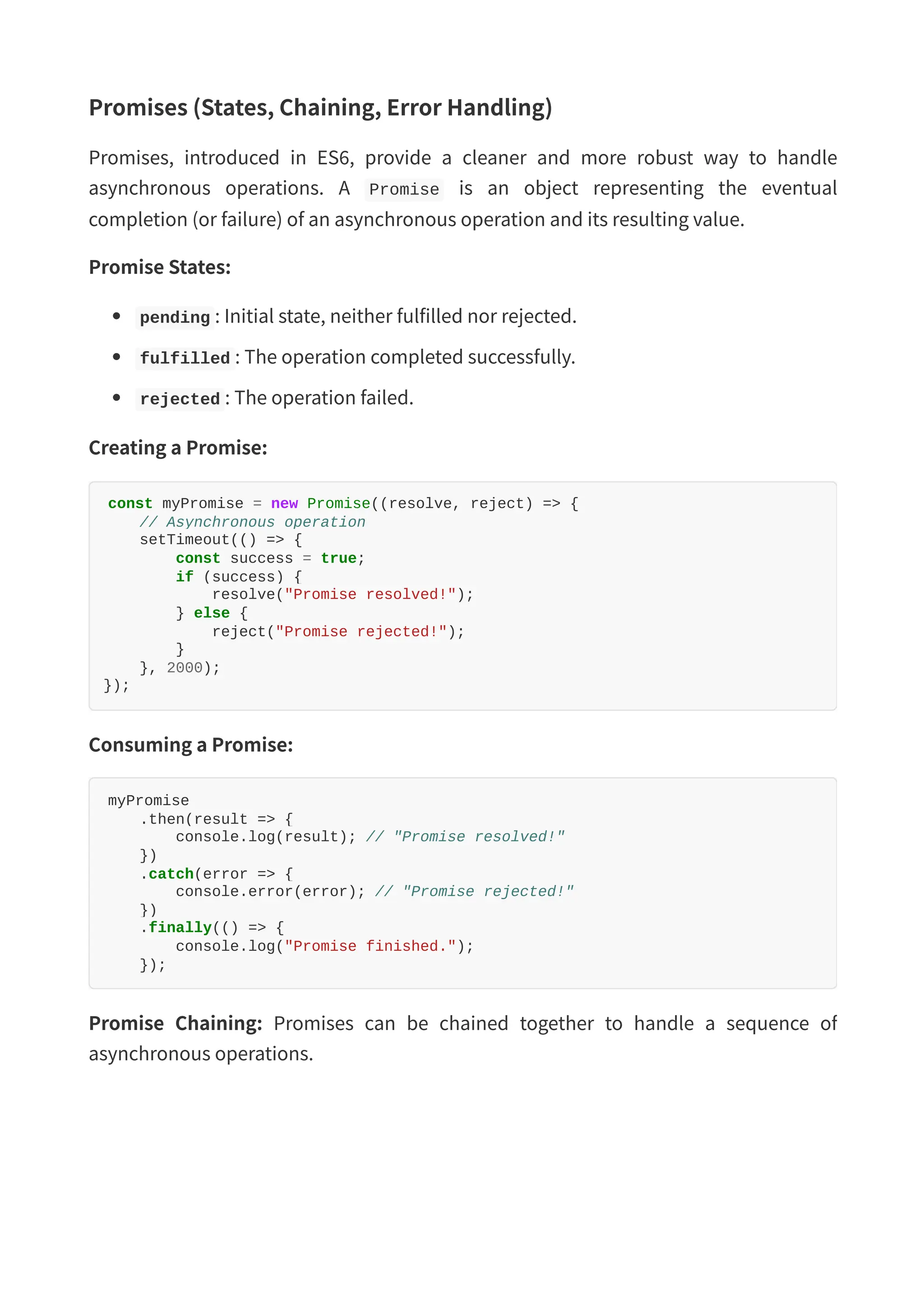
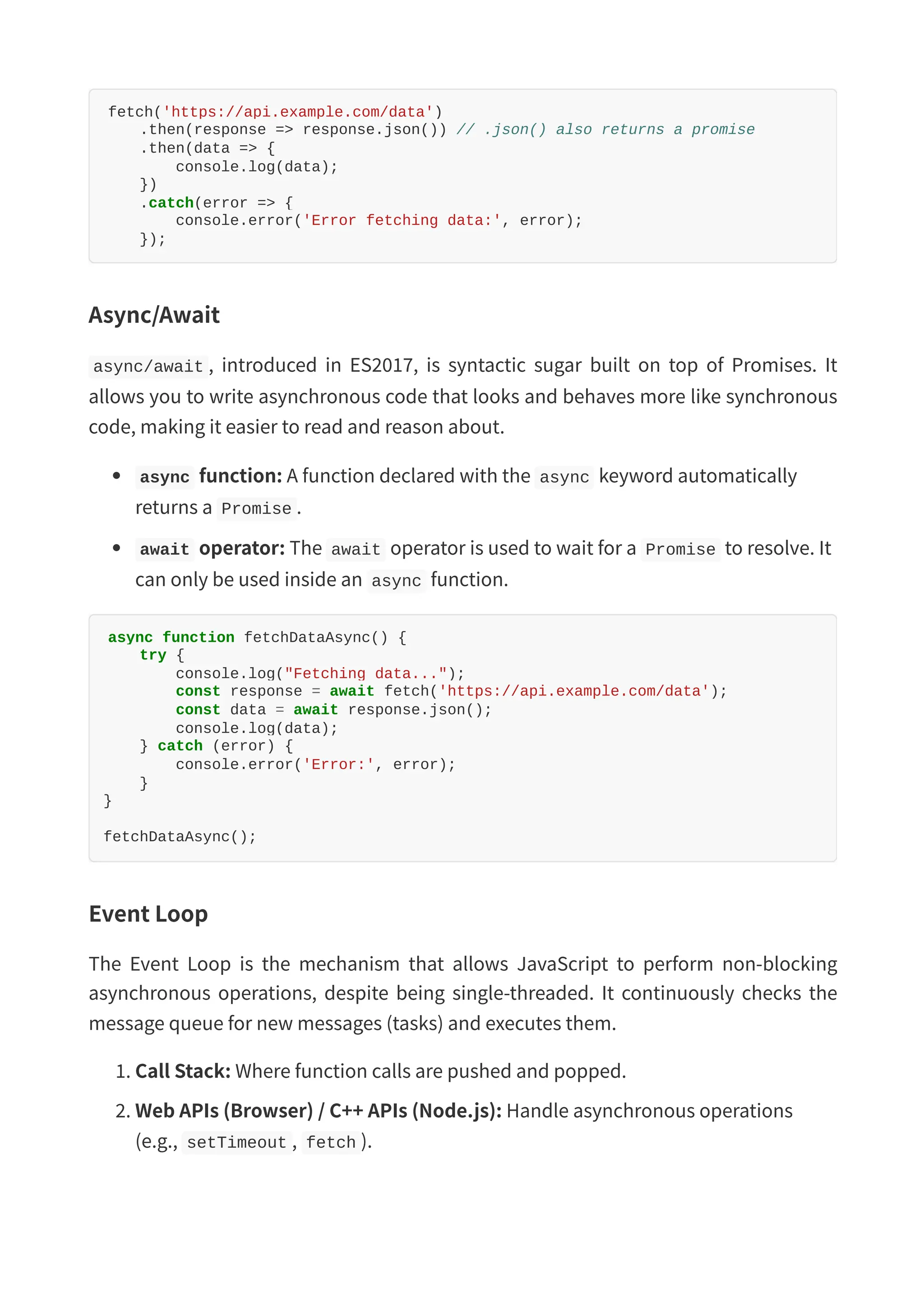
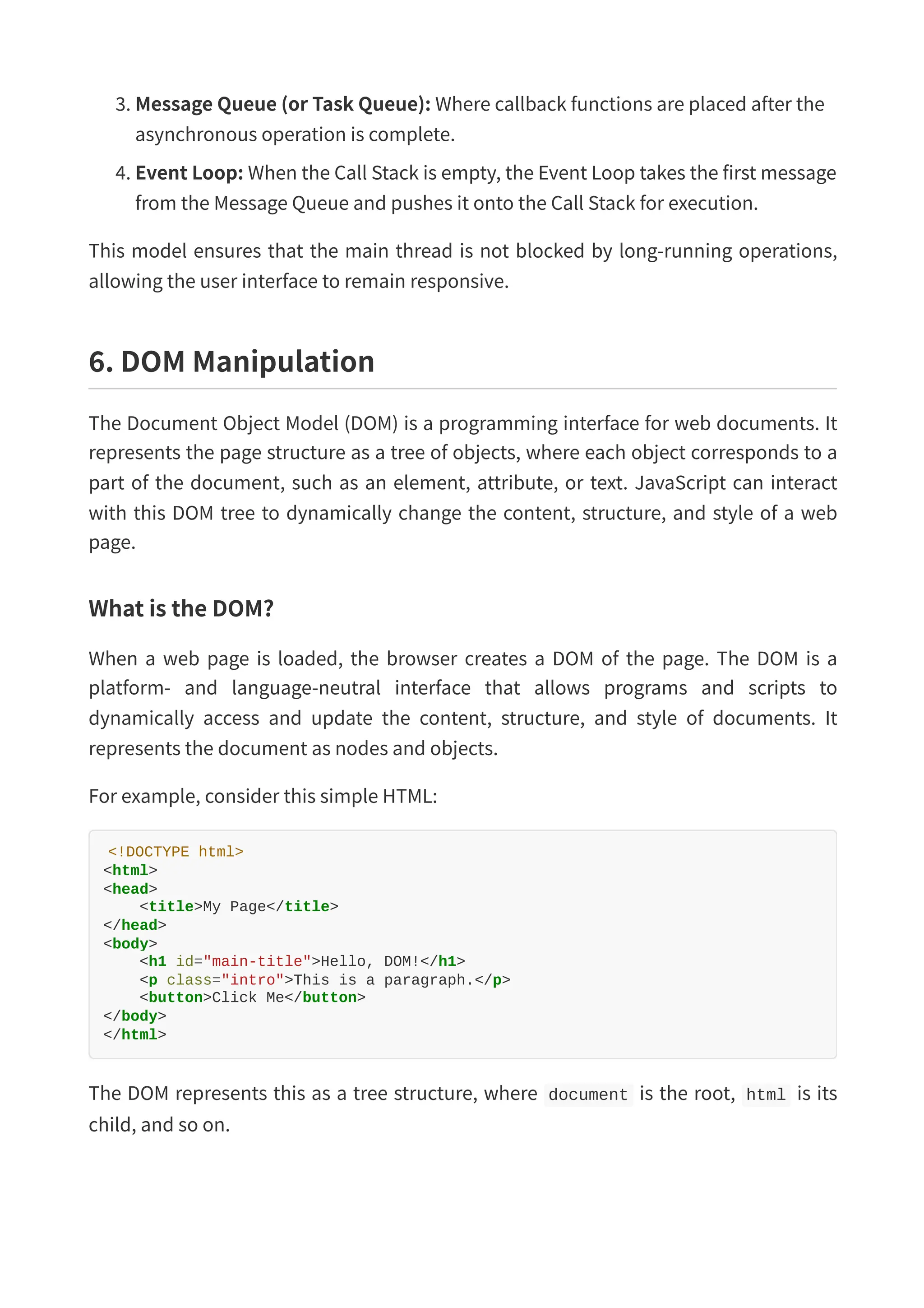
![Selecting Elements To manipulate elements, you first need to select them. JavaScript provides several methods for this: document.getElementById() : Selects a single element by its id attribute. Returns null if the element is not found. javascript const titleElement = document.getElementById("main- title"); console.log(titleElement.textContent); // "Hello, DOM!" document.getElementsByClassName() : Selects all elements with a specific class name. Returns an HTMLCollection (live collection). javascript const introParagraphs = document.getElementsByClassName("intro"); console.log(introParagraphs[0].textContent); // "This is a paragraph." document.getElementsByTagName() : Selects all elements with a specific tag name. Returns an HTMLCollection. javascript const allParagraphs = document.getElementsByTagName("p"); console.log(allParagraphs.length); // 1 document.querySelector() : Selects the first element that matches a specified CSS selector. This is a very versatile method. javascript const firstParagraph = document.querySelector("p.intro"); console.log(firstParagraph.textContent); // "This is a paragraph." const button = document.querySelector("button"); document.querySelectorAll() : Selects all elements that match a specified CSS selector. Returns a NodeList (static collection). javascript const allElements = document.querySelectorAll("h1, p"); allElements.forEach(el => console.log(el.tagName)); // H1, P](https://image.slidesharecdn.com/javascriptnotes-250711141925-adda0041/75/Complete-JavaScript-Notes-From-Basics-to-Advanced-Concepts-pdf-23-2048.jpg)
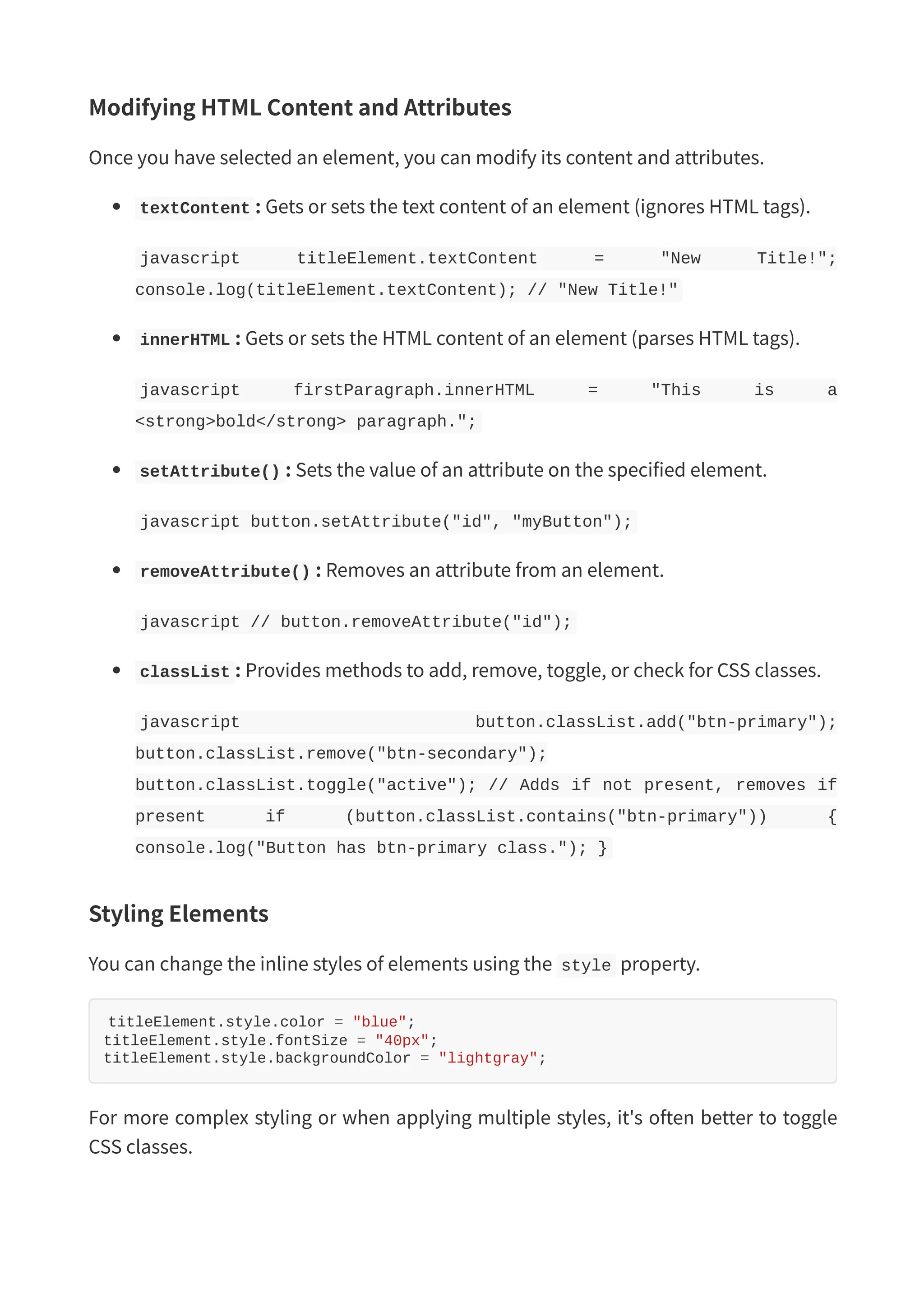
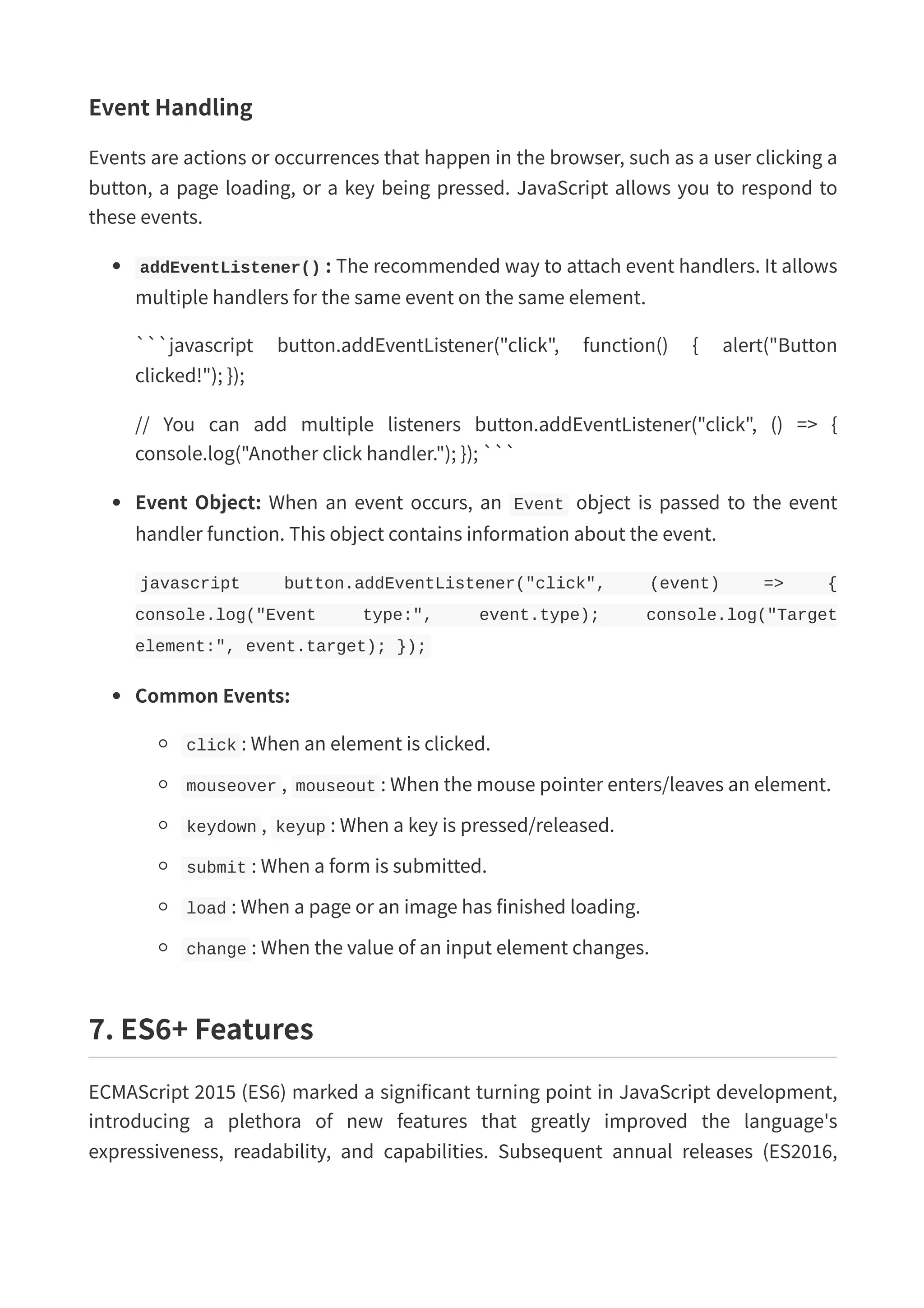
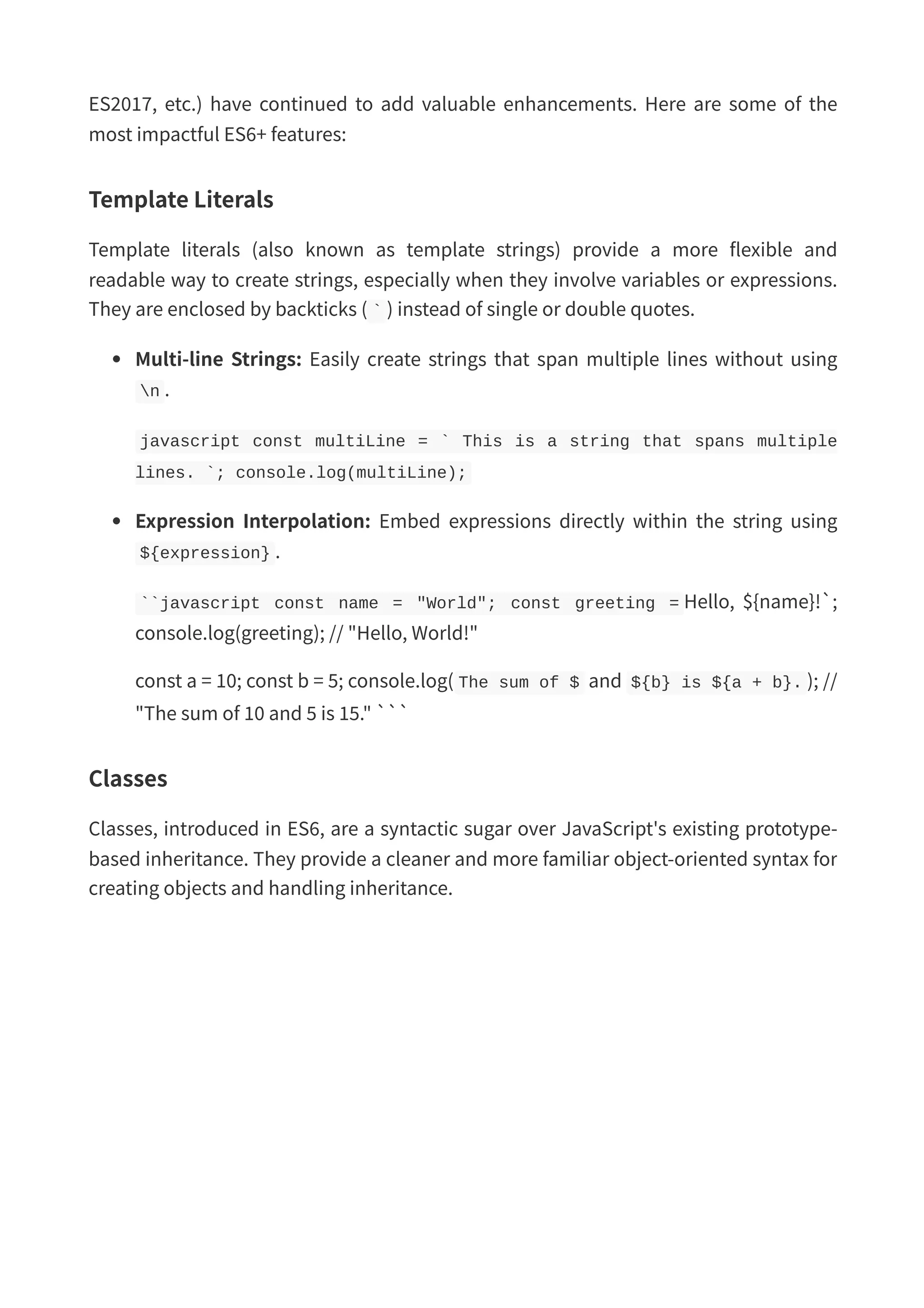
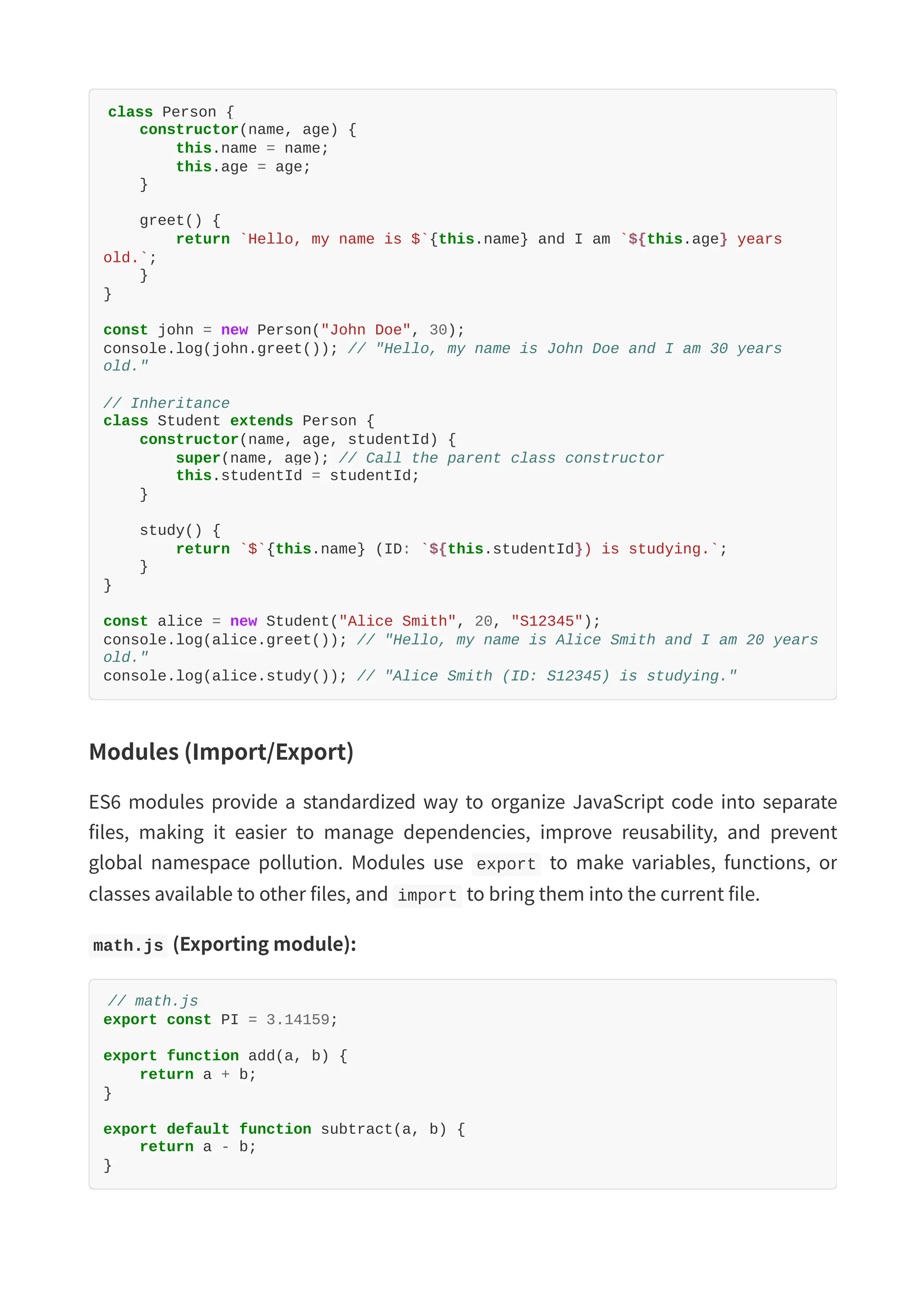
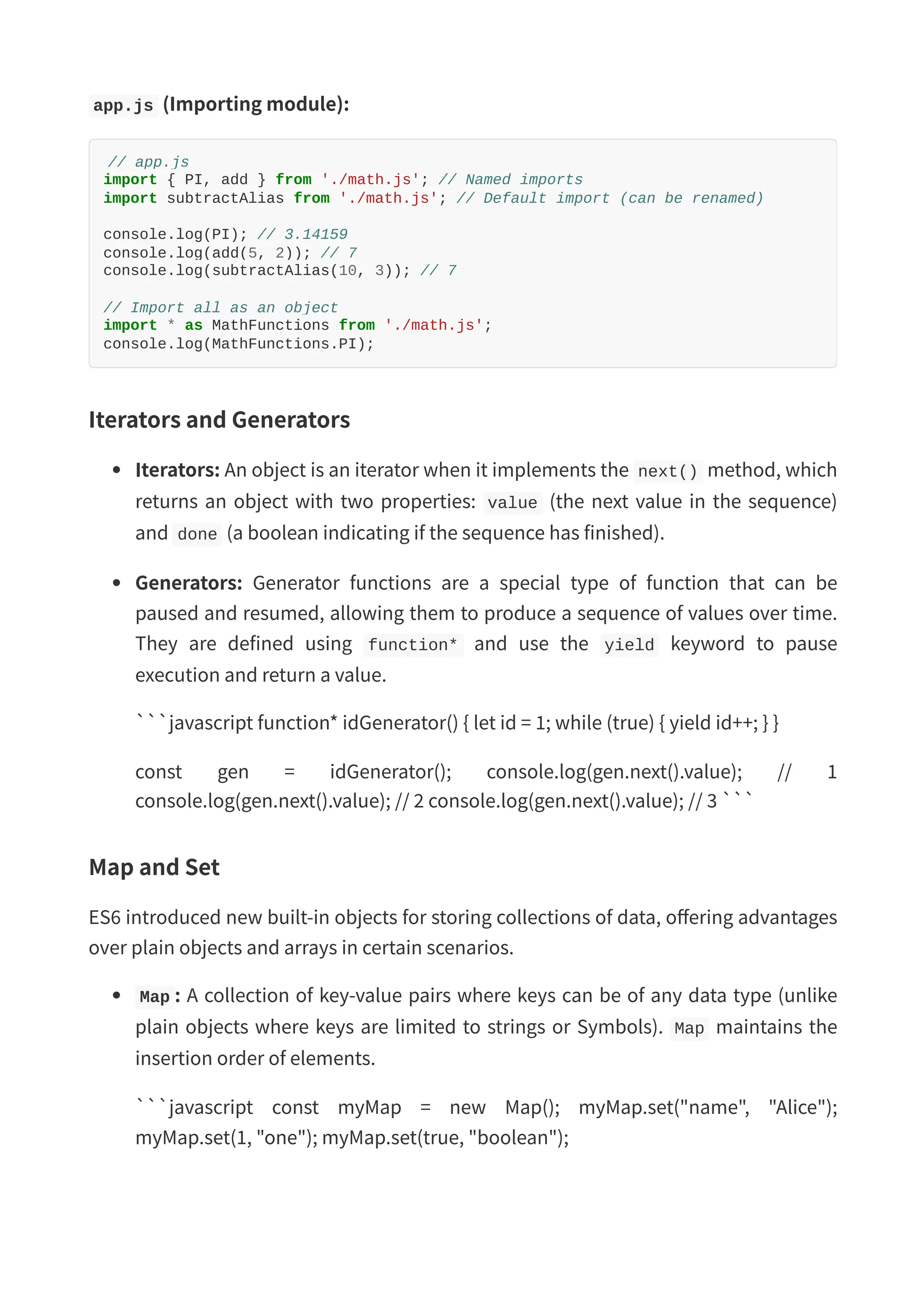
![console.log(myMap.get("name")); // "Alice" console.log(myMap.has(1)); // true myMap.delete("name"); console.log(myMap.size); // 2 // Iterating over a Map for (const [key, value] of myMap) { console.log( $ : ${value} ); } ``` Set : A collection of unique values. Duplicate values are automatically ignored. Set maintains the insertion order of elements. ```javascript const mySet = new Set(); mySet.add(1); mySet.add("hello"); mySet.add(1); // This will be ignored console.log(mySet.has("hello")); // true mySet.delete(1); console.log(mySet.size); // 1 // Iterating over a Set for (const item of mySet) { console.log(item); } // Convert array to Set to get unique values const numbers = [1, 2, 2, 3, 4, 4, 5]; const uniqueNumbers = [...new Set(numbers)]; console.log(uniqueNumbers); // [1, 2, 3, 4, 5] ``` 8. Advanced Concepts Beyond the foundational elements and modern features, JavaScript encompasses several advanced concepts that are crucial for writing robust, efficient, and maintainable code. Understanding these concepts helps in debugging complex issues and mastering the language. this Keyword The this keyword in JavaScript is one of the most misunderstood concepts. Its value is determined by how a function is called, not where it is defined. The this context can change dynamically. Global Context: In the global execution context (outside of any function), this refers to the global object ( window in browsers, global in Node.js). javascript console.log(this === window); // true (in browser)](https://image.slidesharecdn.com/javascriptnotes-250711141925-adda0041/75/Complete-JavaScript-Notes-From-Basics-to-Advanced-Concepts-pdf-29-2048.jpg)
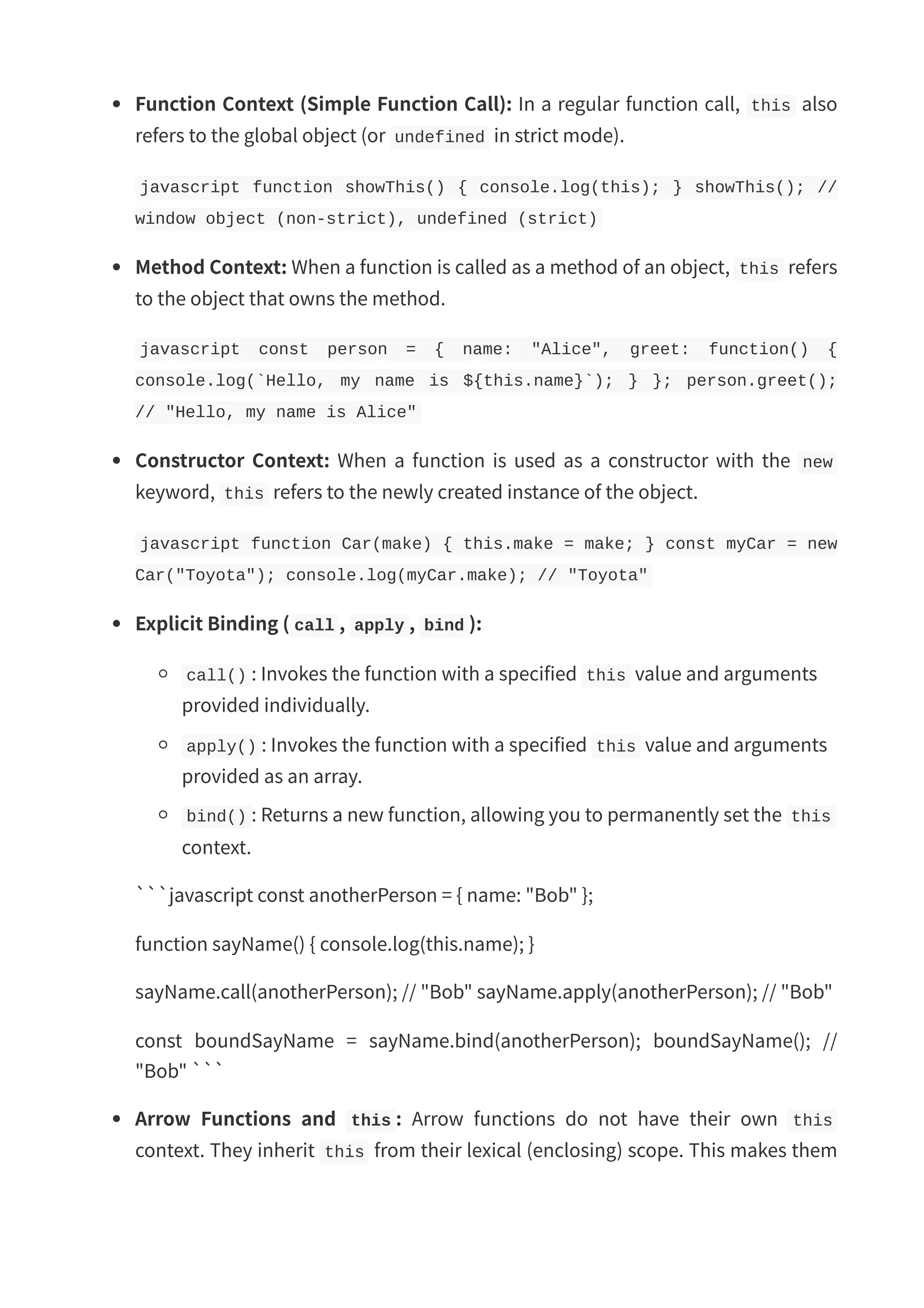
![very useful in callbacks where you want to preserve the this context of the surrounding code. javascript const user = { name: "Charlie", logMessages: function() { setTimeout(() => { console.log(`Hello from ${this.name}`); // 'this' refers to 'user' }, 1000); } }; user.logMessages(); // "Hello from Charlie" (after 1 second) Prototypes and Prototypal Inheritance JavaScript is a prototype-based language, meaning that objects can inherit properties and methods directly from other objects. Every JavaScript object has a prototype, which is another object that it inherits properties and methods from. The prototype chain is how inheritance works in JavaScript. __proto__ and [[Prototype]] : Every object has an internal [[Prototype]] property, which points to its prototype object. This is often exposed via the __proto__ property (though Object.getPrototypeOf() is the standard way to access it). prototype property of functions: Functions in JavaScript also have a prototype property. When a function is used as a constructor (with new ), the prototype property of the constructor function becomes the [[Prototype]] of the newly created object. ```javascript function Vehicle(make) { this.make = make; } Vehicle.prototype.getMake = function() { return this.make; }; const car = new Vehicle("Honda"); console.log(car.getMake()); // "Honda" console.log(car.proto === Vehicle.prototype); // true console.log(Object.getPrototypeOf(car) === Vehicle.prototype); // true ``` Prototype Chain: When you try to access a property or method on an object, JavaScript first looks for it directly on the object. If it doesn't find it, it then looks on the object's prototype, then on the prototype's prototype, and so on, until it reaches null (the end of the chain). javascript // Example of prototype chain console.log(car.toString()); // Inherited from Object.prototype](https://image.slidesharecdn.com/javascriptnotes-250711141925-adda0041/75/Complete-JavaScript-Notes-From-Basics-to-Advanced-Concepts-pdf-31-2048.jpg)
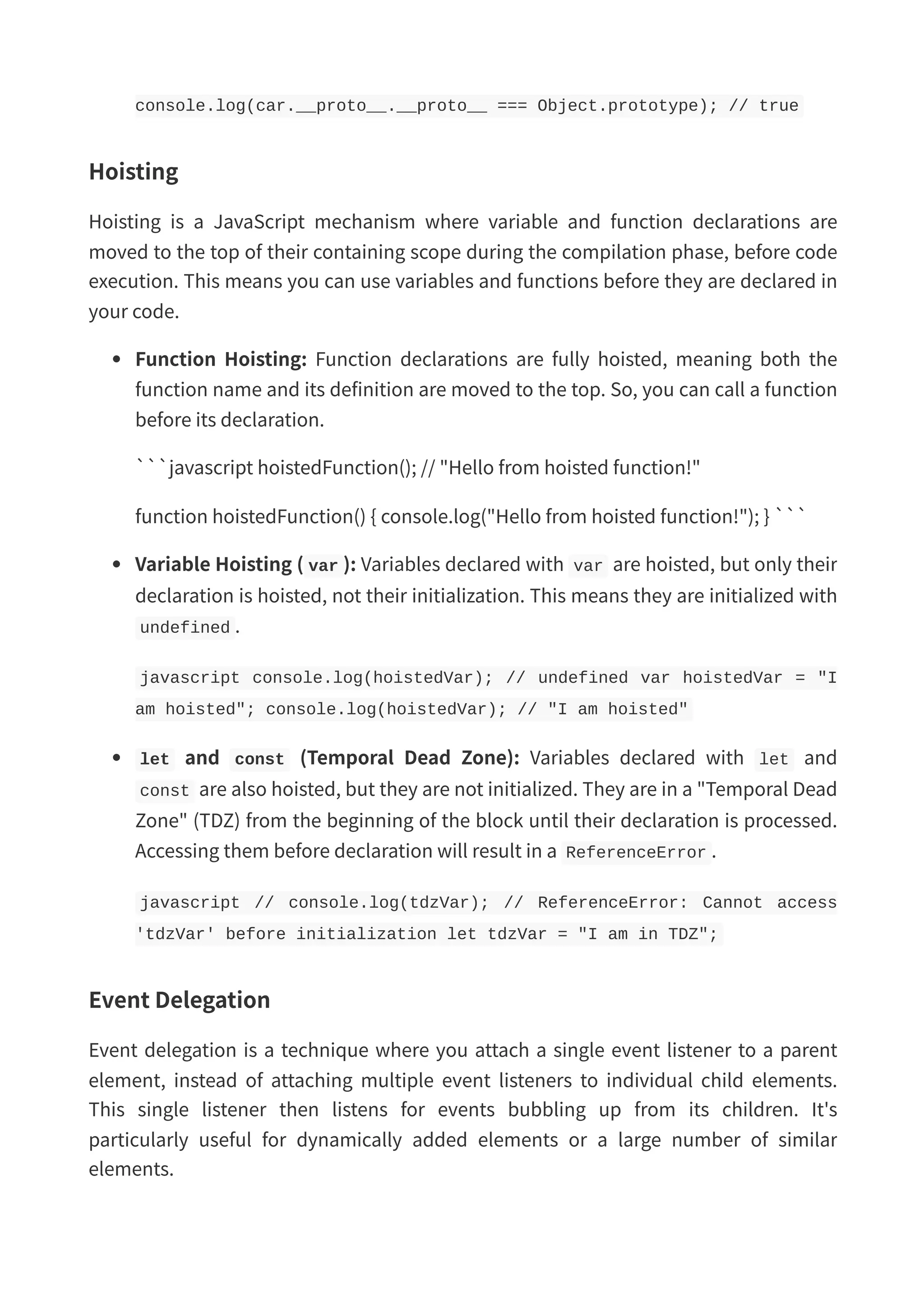
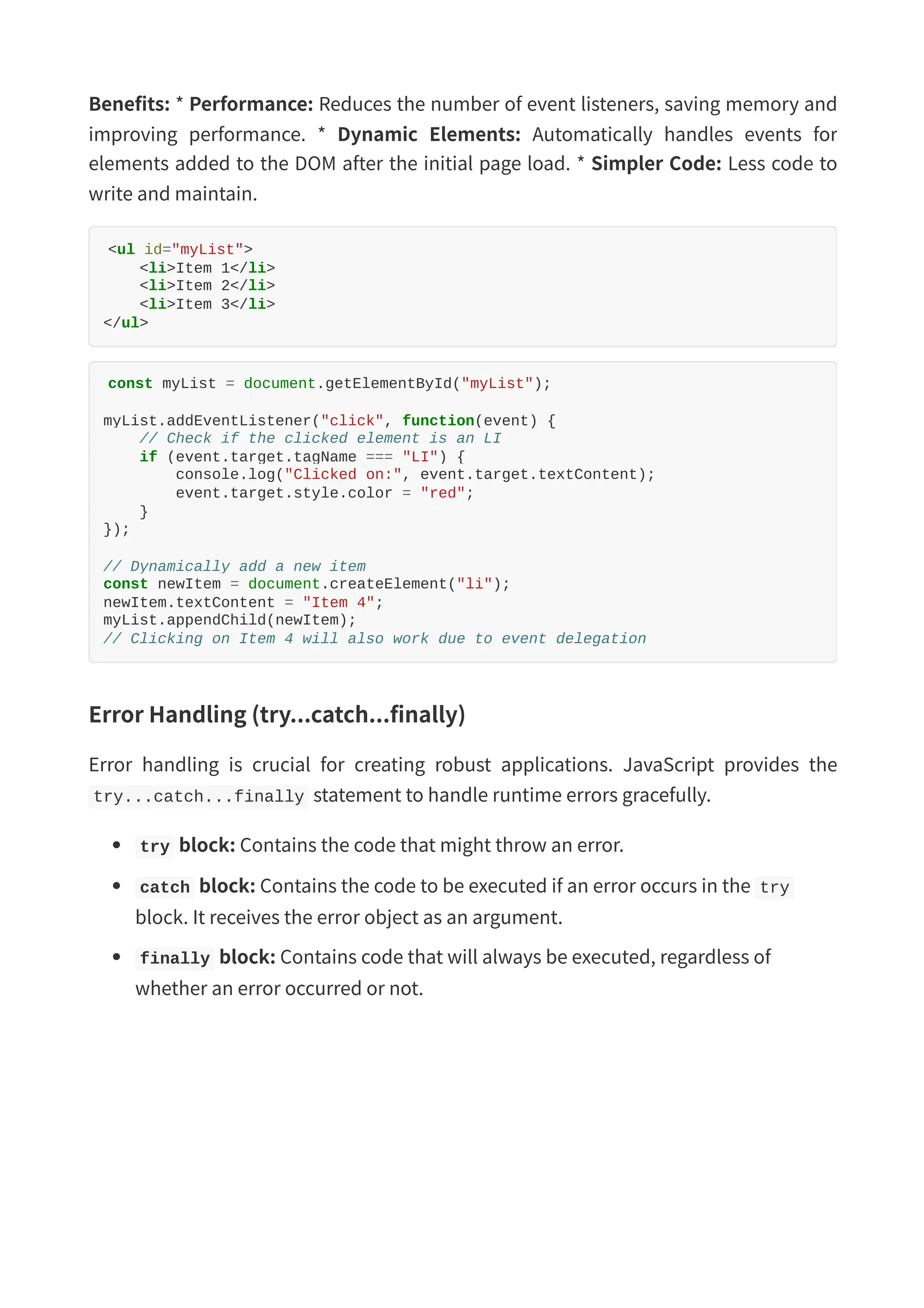
![function divide(a, b) { try { if (b === 0) { throw new Error("Division by zero is not allowed."); } return a / b; } catch (error) { console.error("An error occurred:", error.message); return NaN; // Return Not a Number on error } finally { console.log("Division operation attempted."); } } console.log(divide(10, 2)); // Output: 5, then "Division operation attempted." console.log(divide(10, 0)); // Output: "An error occurred: Division by zero is not allowed.", then NaN, then "Division operation attempted." 9. Modern JavaScript Development Modern JavaScript development involves a rich ecosystem of tools and practices that streamline the development process, improve code quality, and enhance performance. These tools often work together to transform your source code into optimized, production-ready applications. Introduction to npm npm (Node Package Manager) is the default package manager for Node.js and the world's largest software registry. It allows developers to share and reuse code, making it incredibly easy to manage project dependencies and automate development tasks. Installing npm: npm is installed automatically when you install Node.js. package.json : This file is at the heart of any npm project. It stores metadata about the project (name, version, description) and lists all its dependencies ( dependencies for production, devDependencies for development-only tools). json { "name": "my-js-project", "version": "1.0.0", "description": "A simple JavaScript project", "main": "index.js", "scripts": { "start": "node index.js", "test": "echo "Error: no test specified" && exit 1" }, "keywords": [], "author": "Manus AI", "license": "ISC", "dependencies": { "axios": "^1.6.0" }, "devDependencies": { "eslint": "^8.56.0" } }](https://image.slidesharecdn.com/javascriptnotes-250711141925-adda0041/75/Complete-JavaScript-Notes-From-Basics-to-Advanced-Concepts-pdf-34-2048.jpg)
